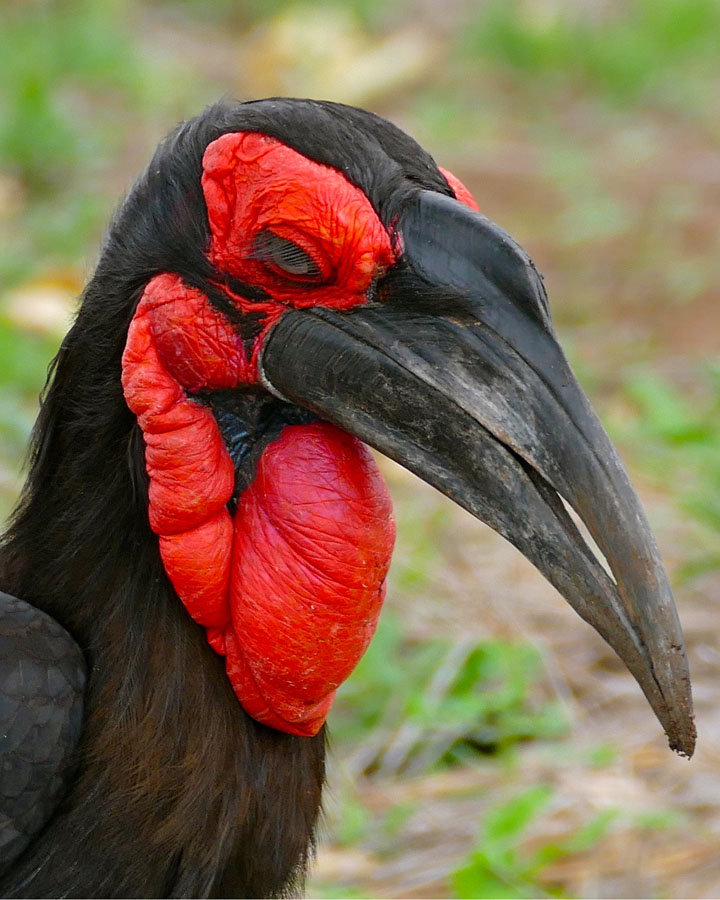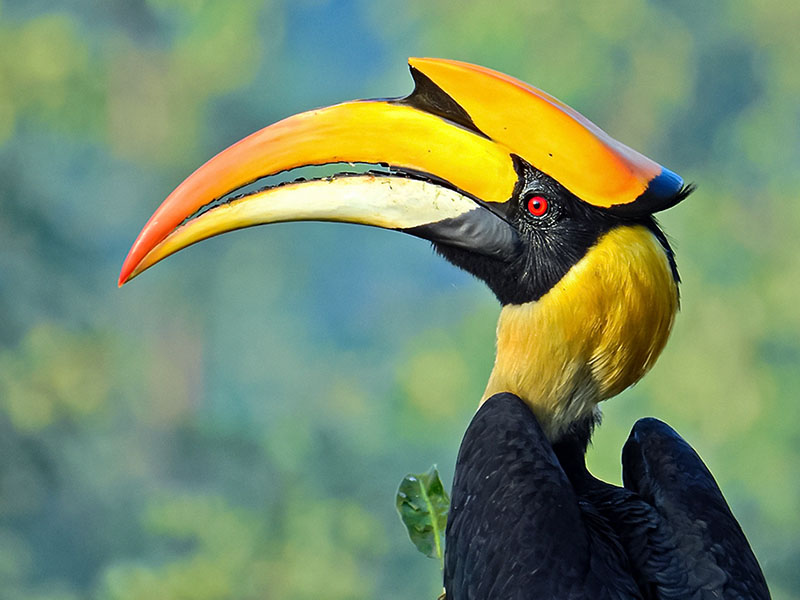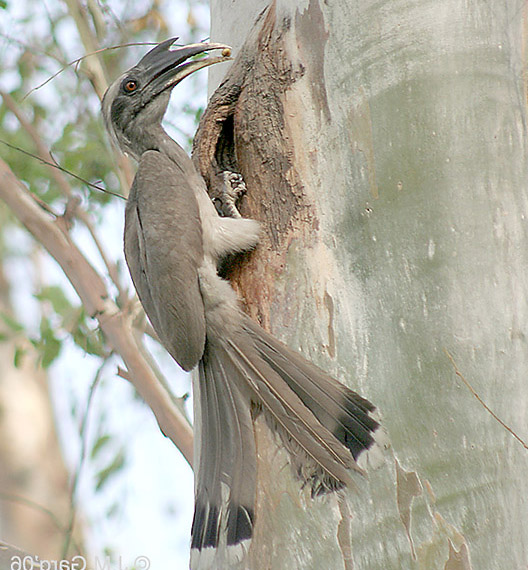THE WORLD BIRDS - An Online Bird Book
BUCEROTIFORMES
HORNBILLs
Order Bucerotiformes Family Bucerotidae
BUCEROTIFORMES
The order Bucerotiformes contains the hornbills, hoopoe and woodhoopoes. In addition to DNA comparisons, these three groups of birds have similar skulls and leg bones. However, the hornbills are very different in appearance and the current thought is that they have a different common ancestor from the hoopoes and woodhoopoes.
HORNBILLs
Order Bucerotiformes Family Bucerotidae
Hornbills are a family of bird found in tropical and subtropical Africa and Asia. They are characterized by a long, down-curved bill which is frequently brightly-colored and sometimes has a casque on the upper mandible. The heavy bill is is used for catching prey, constructing the nest, preening, and also for fighting. Because it is so heavy it is supported by powerful neck muscles and and two neck vertebrae have fused to add support.
A feature unique to the hornbills is the casque, a usually hollow structure that is attached to the top of the bill. In some species it is barely perceptible and appears to serve no function beyond reinforcing the bill. In other species it is quite large, is reinforced with bone, and has openings between the hollow center serving as a resonator for calls.
Hornbills show considerable variation in size, from the black dwarf hornbill (Tockus hartlaubi) which is 32 cm long and 100 grams to the southern ground hornbill which has an average weight of 3700 g. Males are always heavier than their female counterparts, though the extent to which this is true varies according to species. Males also have longer bills, casques, and wings.
The family is omnivorous, feeding on fruit, insects, and small animals. Species that eat mainly fruit are generally found in forests as that is where most of the fruit is. One of their favorite fruits is figs. They will also visit cultivated fruit trees that are not located in forests. The hornbills that prefer insects and small animals prefer more open areas where they can sight and thence catch prey. They cannot swallow food caught at the tip of the beak as their tongues are too short to manipulate it, so they toss it back to the throat with a jerk of the head. Because of their preference for fruit, hornbills play an important role in dispersing their seeds.
Hornbills nest in natural cavities in trees and sometimes cliffs. These cavities are usually natural, often caused by a large limp falling off and subsequent rot resulting in a hole. They are known to use nests that were perviously constructed by woodpeckers and barbets. One of the most amazing habits of the hornbills is that the breeding female will, usually with the help of her mate, partially seal herself into the nest cavity. Hornbills use their bills in this sealing process to construct a wall made out of material such as mud, droppings, and fruit pulp. A space is left in the wall so the male can supply the female and the chicks with whole or regurgitated food. The female will stay in the partially sealed cavity for months while the eggs are laid, and incubated. In some species the female will continue living in the sealed cavity until the chicks fledge, in other species she will leave a few weeks after the first chick hatches and then help her mate feed the young. The female molts while she is sealed in the nest cavity. Think how the nest must smell after months of being almost entirely closed, even containing perhaps a dead chick or two! Why do they go to this extreme behavior? It must be to increase the odds of the chicks surviving attacks from predators.
Many Asian hornbills are threatened by habitat loss, as they tend to require mature trees that provide natural cavities for nesting. Hunting provides an added stress to the population. The African hornbills are generally maintain a stable population, but some of these species are also in trouble. Exacerbating the hornbills stress from humans, many hornbills only produce a maximum of one surviving offspring every year. The first born chick is usually 3 to 5 days older than its sibling; as result it is considerably larger and usually gets the majority of food so the younger chick dies. In essence, the second chick was an insurance policy. If the first born is defective, then chick number 2 gets lucky, otherwise life is hard.
The New World toucans of family Ramphastidae are the birds that most closely resemble the hornbills. Like the hornbills, the toucans have massive brightly colored bills. But these two heavy-billed families are not related. Rather, convergent evolution led them to develop similar bills. The hornbills closest relatives are the hooe and wood hoopies which are in the same order as the hornbills, Bucerotiformes.
Genus Aceros - 1 species
Hornbill,_Rufous-necked Aceros nipalensis
Description: The male rufous-necked hornbill has a rufous head, neck, and underparts. The upperparts are glossy black. It has bare blue skin around the eye and inflatable red throat skin. The lower half of its tail is white. The female is similar with the rufous replaced by black and the skin around the eye duller blue. They are 90 to 100 cm long, The male weighs 2500 grams and the female 2270 g. It nests in a natural cavity high up in a tall forest tree. The female seals the cavity with droppings and food remains. She and the chicks are fed through a small opening by the male. She remains sealed in for about 3 months until the chicks fledge.
Range: Southeast Asia.
Habitat: Dense forests, usually among ridges in mountains.
Diet: Mainly fruit which it usually finds in the canopy.
Conservation status: It is listed as Vulnerable because of its declining population due to habitat loss and hunting.
Image by: 1) Ron_Knight 2) Debmayukh285 - India 3) Kalyanvarma 4) Ujjal_Ghosh - IndiaRange: Southeast Asia.
Habitat: Dense forests, usually among ridges in mountains.
Diet: Mainly fruit which it usually finds in the canopy.
Conservation status: It is listed as Vulnerable because of its declining population due to habitat loss and hunting.
1) Pair 2) Female 3, 4) Male
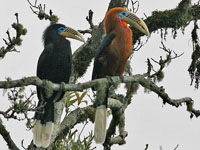
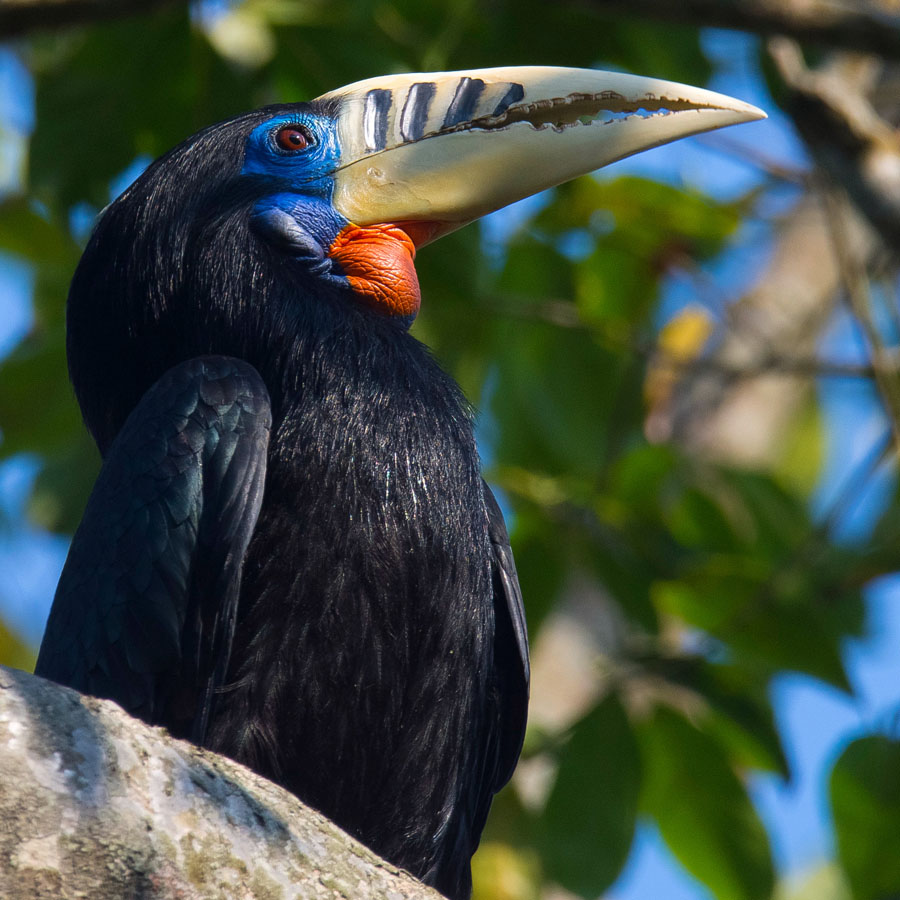
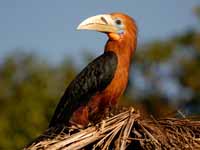
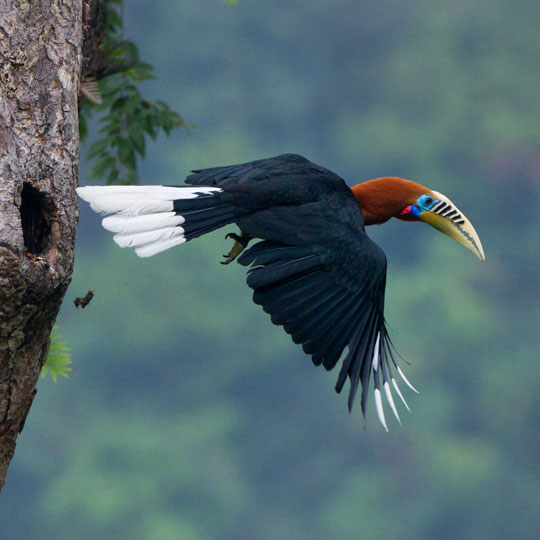
Genus Anorrhinus
They are found in forests of Southeast Asia (just barely extending into adjacent parts of India and China). They are social and typically seen in groups, but only the dominant pair are believed to breed, while other group members act as helpers. Because of habitat destruction, all three species are listed as Near Threatened.
Hornbill,_Brown Anorrhinus austeni
Description: The brown hornbill, also known as Austen's brown hornbill, has brown plumage. The male has white cheeks and throat, a pale creamy bill, and pale rufous-brown underparts. The female has a dark head and throat. They are 60 to 65 cm long.
Range: Northeast India south to Vietnam and Thailand.
Habitat: Mainly hilly forest.
Diet: Fruits, insects, arachnids, bats, snakes, earthworms, chicks, eggs.
Conservation status: The brown hornbill is listed as Near Threatened because of declining population due to deforestation.
Image by: 1) Pkspks 2, 3, 4) LonelyShrimp- Thailand Range: Northeast India south to Vietnam and Thailand.
Habitat: Mainly hilly forest.
Diet: Fruits, insects, arachnids, bats, snakes, earthworms, chicks, eggs.
Conservation status: The brown hornbill is listed as Near Threatened because of declining population due to deforestation.
1) Female 2 - 4) Male
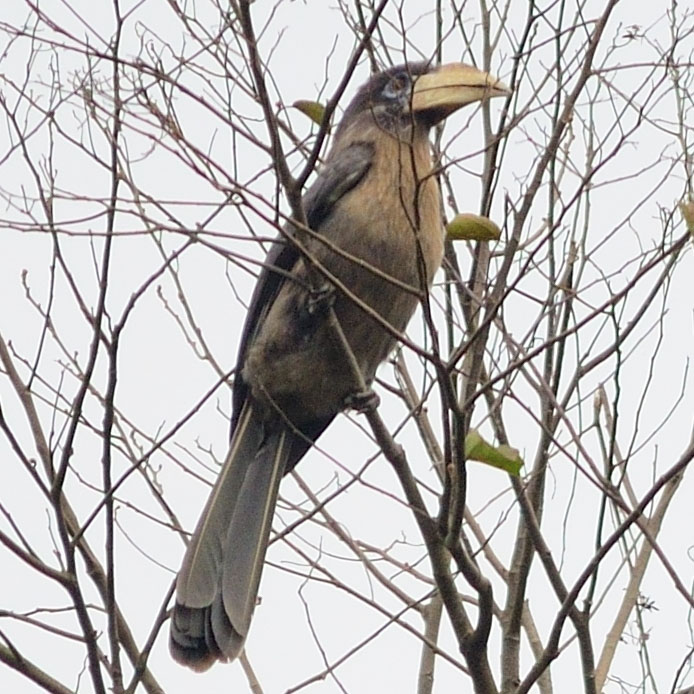
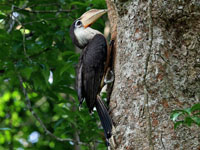
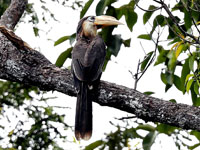
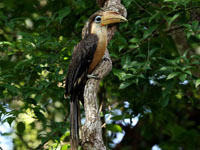
Hornbill,_Bushy-crested Anorrhinus galeritus
Description: The bushy crested hornbill has mainly black plumage. It has whitish bare skin to the rear of he eye and another pale patch at the top of the throat. Both patches usually have some blue. The tail is pale grey-brown with a wide terminal black band. the male has a black bill and the female's bill has a black base, but is mostly yellow. They are 65 to 70 cm long and weigh 1125 to 1250 grams. The nest in a natural tree cavity.
Range: Southeast Asia, Indonesia, Malaysia.
Habitat: Mainly foothill forests, especially with fig trees. Likes clearings and being close to rivers and streams.
Diet: Fruits, insects, lizards, frogs.
Conservation status: The bushy-crested hornbill is listed as Near Threatened because of habitat destruction including illegal lgging in parks.
Image by: 1) Dick_Culbert 2) Tony_Castro 3) David_Cook - Borneo Range: Southeast Asia, Indonesia, Malaysia.
Habitat: Mainly foothill forests, especially with fig trees. Likes clearings and being close to rivers and streams.
Diet: Fruits, insects, lizards, frogs.
Conservation status: The bushy-crested hornbill is listed as Near Threatened because of habitat destruction including illegal lgging in parks.
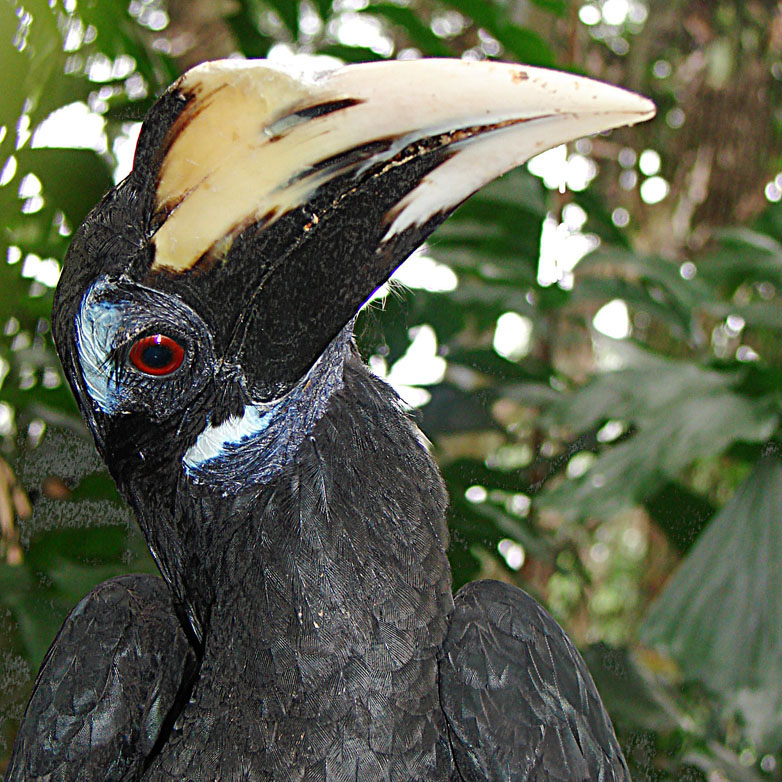
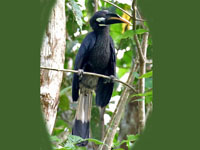

Hornbill,_Rusty-cheeked also Tickell's Hornbill Anorrhinus tickelli
Description: The rusty-cheeked hornbill, also known as Tickell's hornbill, has dark brown upperparts and reddish-brown underparts. The male has brighter rufous cheeks and throat than the female. It is 60 to 65 cm long with the male weighing 850 to 910 grams and the female 680 to 800 g.
Range: Burma, Thailand.
Habitat: Evergreen and deciduous forest from foothills to 1500 m.
Diet: Little known. Probably similar to Austen's brown hornbill as they are thought to be closely related.
Conservation status: The rusty-cheeked hornbill is listed as Near Treated because of logging and agriculture expansion.
Image by: 1) Mike 2) Jason ThompsonRange: Burma, Thailand.
Habitat: Evergreen and deciduous forest from foothills to 1500 m.
Diet: Little known. Probably similar to Austen's brown hornbill as they are thought to be closely related.
Conservation status: The rusty-cheeked hornbill is listed as Near Treated because of logging and agriculture expansion.
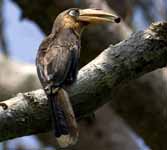
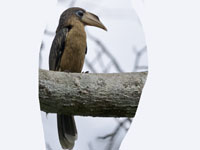
Genus Anthracoceros
These are the blac Asian hornbills. They all have mainly black plumage. Some have white bare skin around the eyes and a white throat patch. And some also have a white tail.
Hornbill,_Black Anthracoceros malayanus Found, Asia
Description: The black hornbill has mainly black plumage. It often has a white or pale grey supercilium, and a yellowish throat patch. The black tail has 2 elongated central feathers while the outer tails feather end in a white tip. The male has a yellowish bill and casque while the female has a dark grey bill and casque. It is 60 to 65 cm long and weighs about 1000 grams.
Range: Singapore, Thailand, Borneo.
Habitat: Primary forest usually below 200 m. Will use less pristine forests.
Diet: Fruits high in fat content. Also insects, bats, eggs.
Conservation status: It is listed as Vulnerable because of declining population due to habitat distruction.
Image by: 1) Mahbob
Yusof 2) Neil Phillips- the London Zoo 3) Mike_Prince - Borneo 4) Petra_Karstedt Range: Singapore, Thailand, Borneo.
Habitat: Primary forest usually below 200 m. Will use less pristine forests.
Diet: Fruits high in fat content. Also insects, bats, eggs.
Conservation status: It is listed as Vulnerable because of declining population due to habitat distruction.
1) Female 2, 3, 4) Male
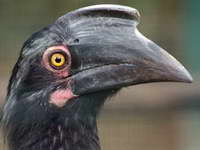
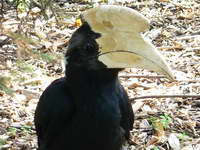
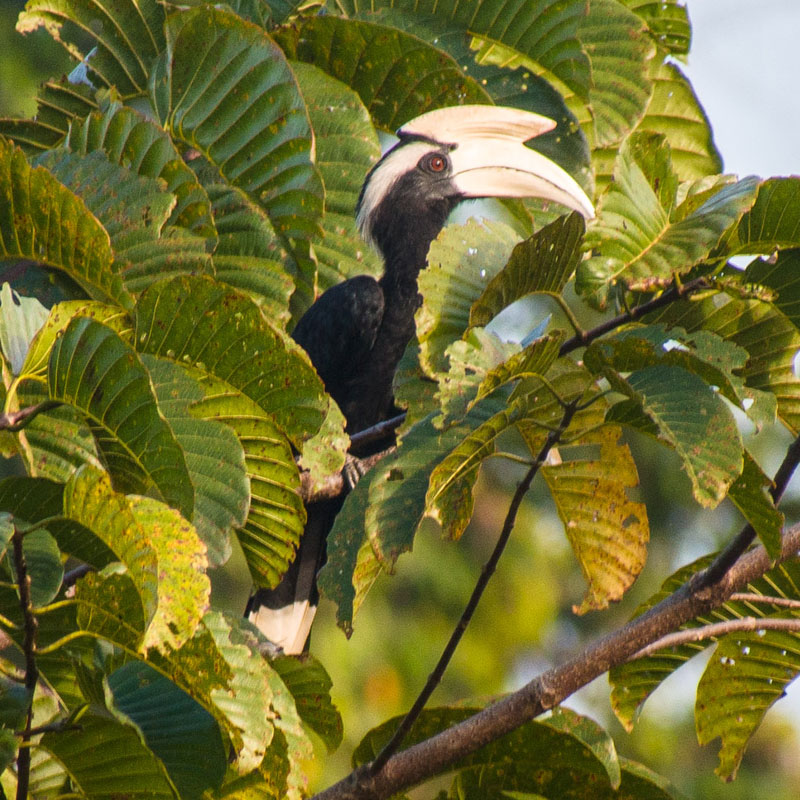
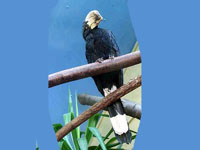
Hornbill,_Malabar_Pied Anthracoceros coronatus
Description: The Malabar pied hornbill has black upperparts, neck, and breast. It has a white belly, skin around eyes, and throat patch. It has a large yellow bill with a mainly black casque. Females have white orbital skin.
Range: Southern India and Sri Lanka.
Habitat: Forests with space to maneuver and fruit available, plantations, isolated fruit trees.
Diet: Mainly fruits; also iscellaneous animals.
Conservation status: It is listed as Neat Threatened because of habitat destruction.
Image by: 1) Uday_Agashe 2) Steve Garvie - Sri Lanka 3, 4)
Thimindu Goonatillake - Sri Lanka Range: Southern India and Sri Lanka.
Habitat: Forests with space to maneuver and fruit available, plantations, isolated fruit trees.
Diet: Mainly fruits; also iscellaneous animals.
Conservation status: It is listed as Neat Threatened because of habitat destruction.
1) Pair, male on left 2) Female 3, 4) Male
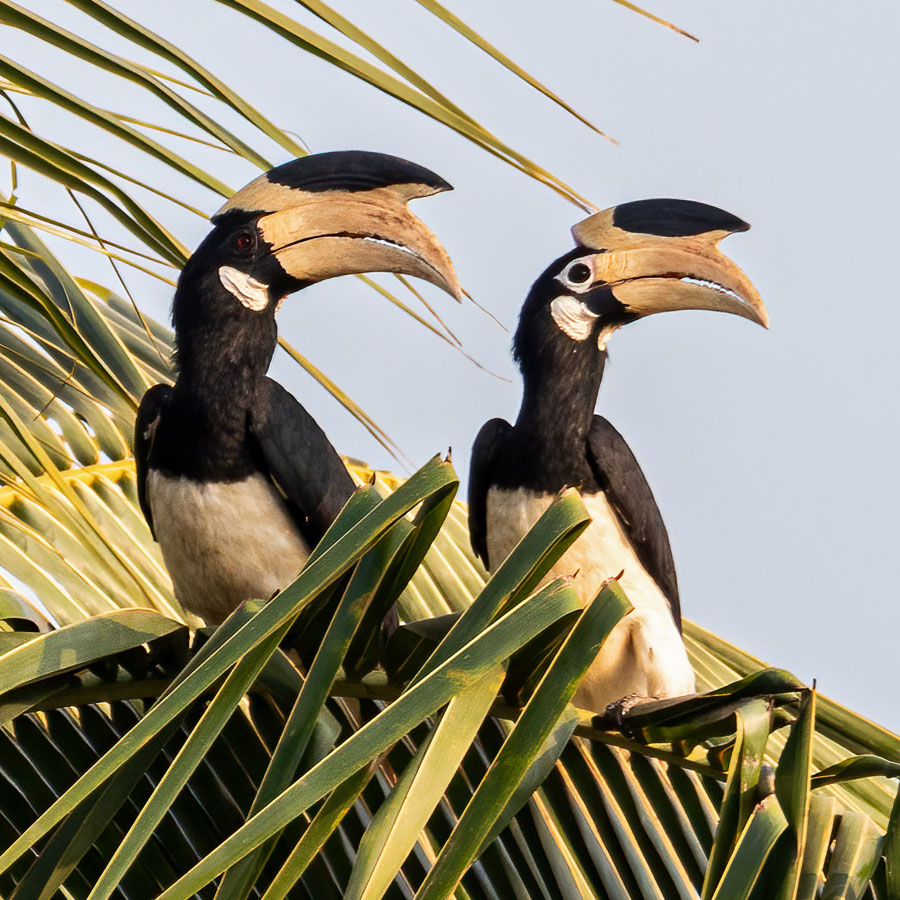


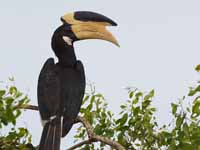
Hornbill,_Oriental Pied Anthracoceros albirostris
Description: The Oriental pied hornbill has black upperparts, neck, and breast, It has a white belly, skin around eyes. and a white throat patch. The bill is mainly pale yellow with a black base to the lower mandible. The female has more black on her bill than the male. The under-wing feathers are are black with white tips. The upper-tail feathers are black white the under-taile feathers are white except the center feathers are black. The Oriental pied hornbill is 55 to 60 cm long, the female averages 875 grams, and the male 900 g. There are not colonial nesters. The pair shares most of the cavity nest preparations and sealing.
Range: Asia.
Habitat: Subtropical or tropical moist lowland forests.
Diet: Lipid rich fruit and invertebrates during breeding season. Sugar rich fruits duing nonbreeding season.
Conservation status: Least Concern.
Image by: 1) LonelyShrimp - Thailand 2) Mahbob Yusof 3) Dick Daniels - Bronx Zoo 4) Paul_Williams - MalaysiaRange: Asia.
Habitat: Subtropical or tropical moist lowland forests.
Diet: Lipid rich fruit and invertebrates during breeding season. Sugar rich fruits duing nonbreeding season.
Conservation status: Least Concern.
1) Male left, female right 2) Female 3) Male

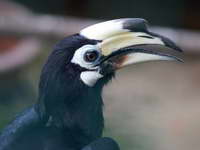
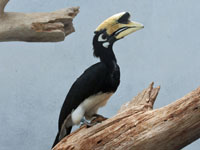
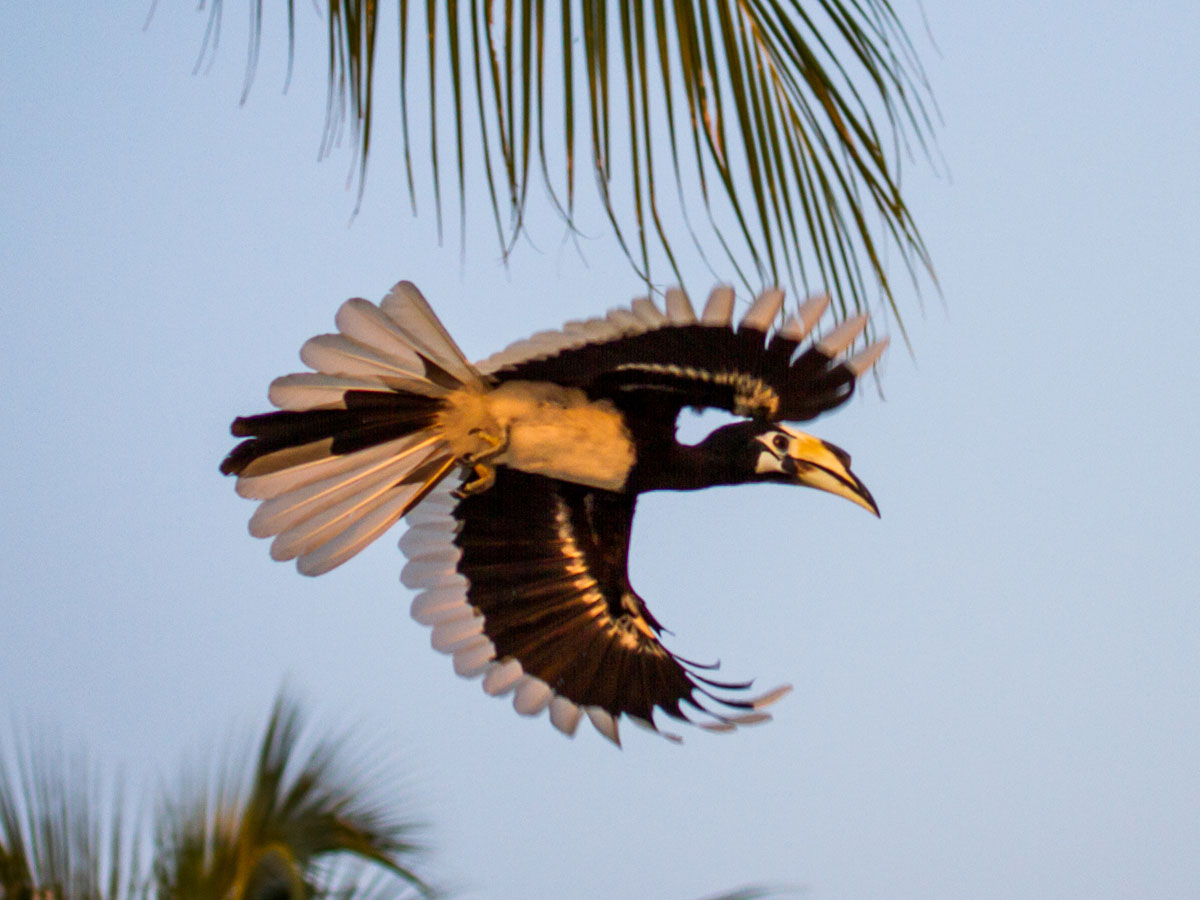
Hornbill,_Palawan Anthracoceros marchei
Description: The Palawan hornbill has mainly black plumage. It has white skin around the eye, white throat patch, and white tail. The male is bigger and has a proportionally larger casque.
Range: Palawan island of he Philippines.
Habitat: Evergreen forests; also mangrove swamps.
Diet: Mainly fruit. Also insects, lizards.
Conservation status: The Palawan hornbill is listed as Vulnerable because of deforestation and hunting.
Image by: 1) Limchiu 2) Raniel_jose_castanedaRange: Palawan island of he Philippines.
Habitat: Evergreen forests; also mangrove swamps.
Diet: Mainly fruit. Also insects, lizards.
Conservation status: The Palawan hornbill is listed as Vulnerable because of deforestation and hunting.
1) Male at top
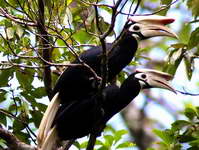
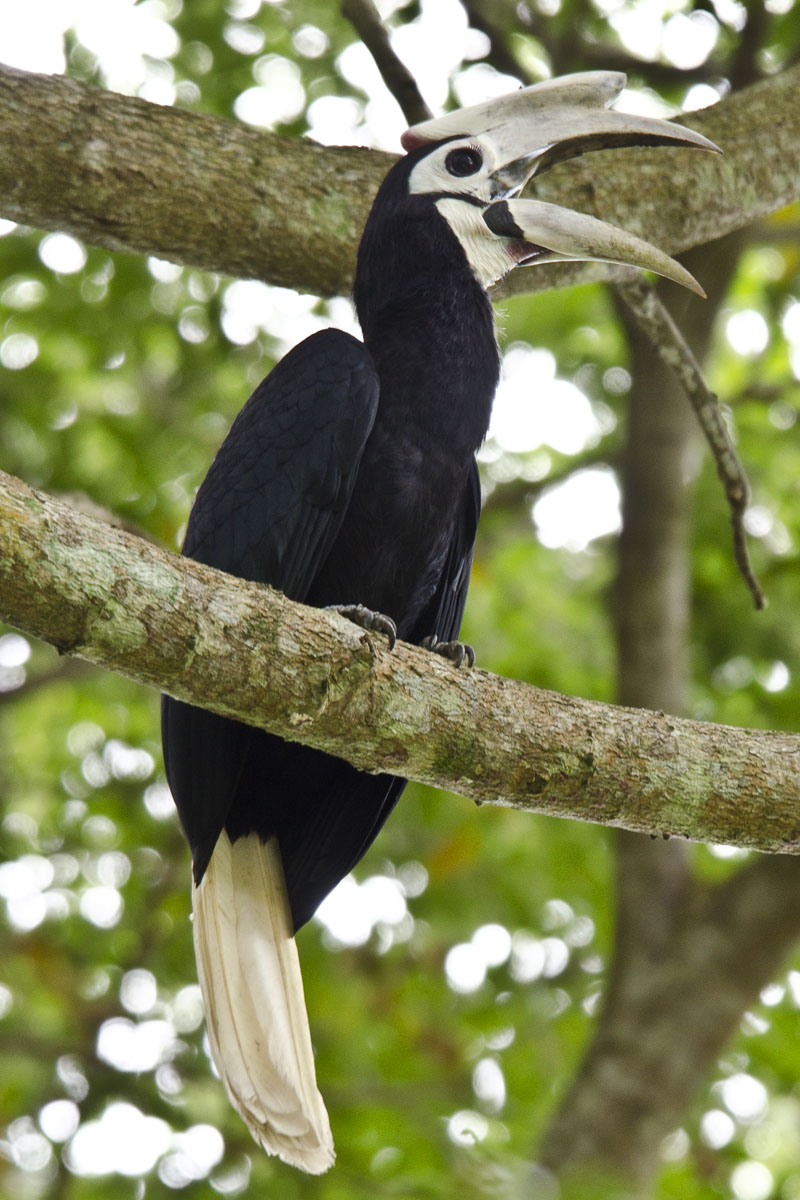
Hornbill,_Sulu Anthracoceros montani
Description: The Sulu hornbill has all black plumage except for a white tail. The bill and casque is also black.
Range: Sulu archipelago in the Philippines.
Habitat: Evergreen forests.
Diet: Mainly fruit. Also insects, lizards.
Conservation status: The Sulu hornbill is listed as Critically Endangered because of low population - perhaps less then 30 in the wild.
Image by:
1) Biodiversity_Heritage_Library Range: Sulu archipelago in the Philippines.
Habitat: Evergreen forests.
Diet: Mainly fruit. Also insects, lizards.
Conservation status: The Sulu hornbill is listed as Critically Endangered because of low population - perhaps less then 30 in the wild.

Genus Berenicornis - 1 species
Hornbill,_White-crowned Berenicornis comatus
Description: The White-crowned hornbill has white crown feathers that are erected in a crest. It also has a white head, neck, underparts, and tail. The wing-tips are white. The remaining plumage is black. It is 83 to 102 cm in length and weighs 1300 to 1500 grams, with the male being larger.
Range: Southeast Asia, Malaysia, Indonesia.
Habitat: Lowland evergreen forests and dense secondary growth.
Diet: Mainly fruit; also lizards, insects, and their larvae.
Conservation status: The white-crowned hornbill is listed as Endangered because it is now only rarely observed.
Image by: 1, 2) Choy Wai Mun - Nalaysia 3) Tapir Girl - Franklin Park Zoo Bernard_Dupont Peter_StewardRange: Southeast Asia, Malaysia, Indonesia.
Habitat: Lowland evergreen forests and dense secondary growth.
Diet: Mainly fruit; also lizards, insects, and their larvae.
Conservation status: The white-crowned hornbill is listed as Endangered because it is now only rarely observed.
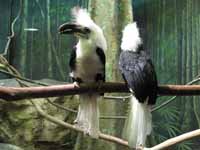
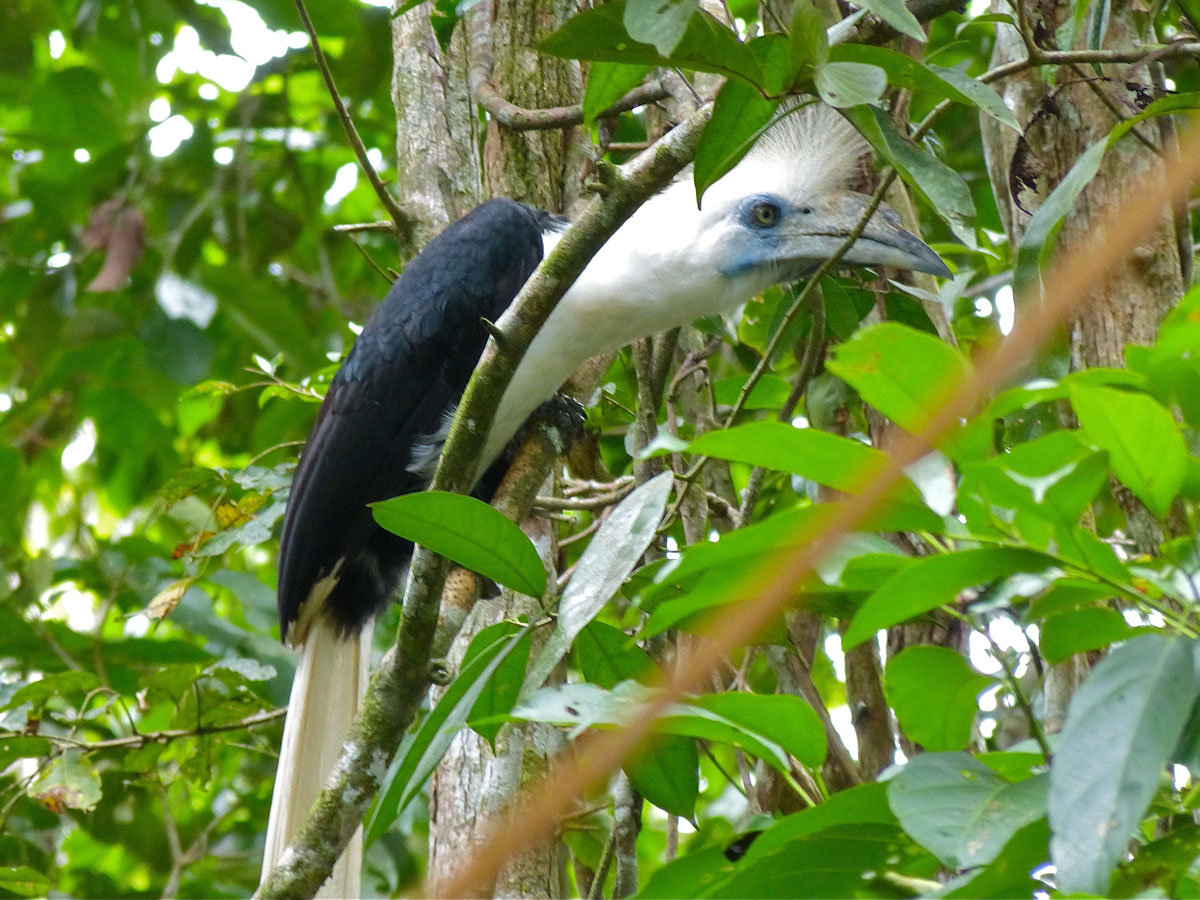

Genus Buceros
These are large hornbills which all have a large, hollow casque. They have the largest wingspan of all the hornbills, up to 1.8 meters.
Hornbill,_Great also Great Indian Hornbill Buceros bicornis
Description: The bill and casque of the great hornbill, also known as great Indian hornbill, are mainly yellow and they have a black base. The front of the male's casque is black while it is yellow for the female. The body is mainly black with part of the white head and neck covered with yellow preen oil. It has a white tail with a wide black band. It is one of the largest Asian hornbills with a length of 100 cm, the male 3000 grams, and the female 2700 grams.
Range: Indian Subcontinent, Southeast Asia.
Habitat: Primary evergreen forests.
Diet: Mainly fruit; also insects, and small reptiles, birds, mammals.
Conservation status: It is listed as Near Threatened because of habit destruction which reduces the number of cavity trees available for nesting.
Image by: 1) Eric_Kilby 2) Joachim Muller 3) Stavenn - Bronx Zoo 4) Lip Kee - MalaysiaRange: Indian Subcontinent, Southeast Asia.
Habitat: Primary evergreen forests.
Diet: Mainly fruit; also insects, and small reptiles, birds, mammals.
Conservation status: It is listed as Near Threatened because of habit destruction which reduces the number of cavity trees available for nesting.
1) Female 2) Male
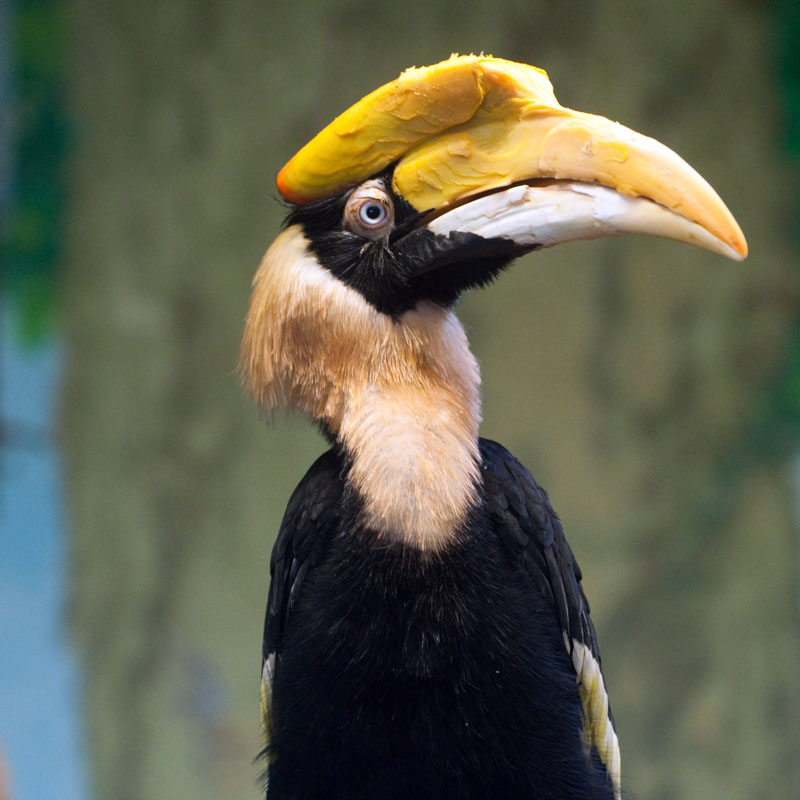
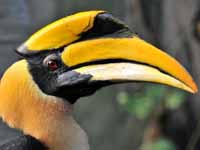
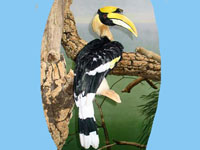
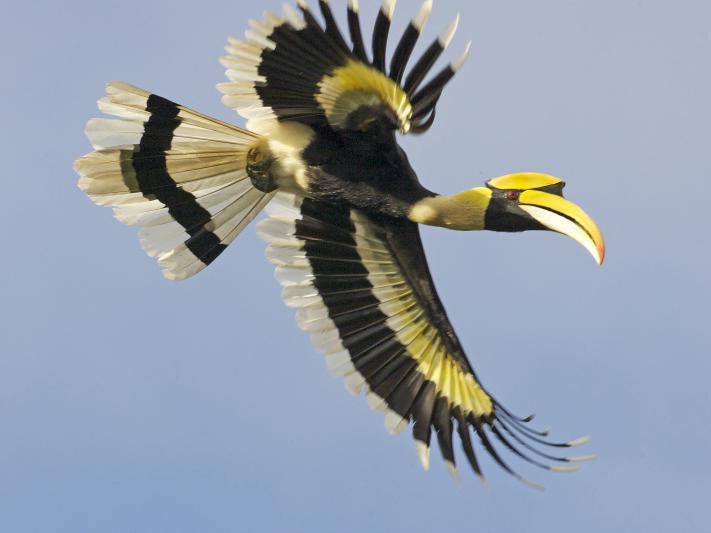
Hornbill,_Helmeted Buceros vigil
Description: The helmeted hornbill has black upperparts, head, and breast. It has a white belly and legs. The white tail has a black band. There is a bare and wrinkled throat patch. The bill is naturally yellow, but the secretions from the preen gland usually turn the bill and casque red. The casque is solid unlike other hornbills and thus quite heavy. Males will have territorial fights, jousting with the heavy and hard casques. Ther are 110 to 120 cm long, which is long for hornbills. Part of this length is due to its uniquely long tail. Males weigh about 3050 grams and females 2725. They nest in natural cavities of tall trees.
Range: Thailand, Malaysia, Indonesia .
Habitat: Primary evergreen forests, but also selectively logged forests.
Diet: Mainly fruit, especially figs. Also small mammals, snakes, birds.
Conservation status: The helmeted hornbill is listed as Critically Endangered because many have been killed for their uniques casques.
Image by: 1) Farquhar 2) Doug Janson Range: Thailand, Malaysia, Indonesia .
Habitat: Primary evergreen forests, but also selectively logged forests.
Diet: Mainly fruit, especially figs. Also small mammals, snakes, birds.
Conservation status: The helmeted hornbill is listed as Critically Endangered because many have been killed for their uniques casques.
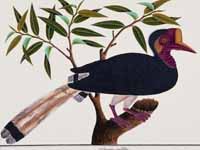
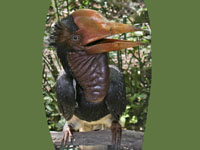
Hornbill,_Rhinoceros Buceros rhinoceros
Description: The rhinoceros hornbill has mainly black plumage. Its name refers to the male's very large orange up-curved casque. His bill and casque have black at their base. There is usually red on the bill and casque originating from the preen gland. The female has a smaller bill and casque and there is no black on the bill.The male has red eyes and the female has white eyes and red eye-rings. They are 80 to 90 cm long, male about 2700 grams, and female 2200 g.
Range: Thailand, Malaysia, Indonesia.
Habitat: Primary evergreen forest; also tall secondary forests.
Diet: Mainly fruit, especially figs. Also almost any small animal it can catch.
Conservation status: It is listed as Vulnerable because of deforestation due to logging and agriculture plus it is hunted for its casque.
Image by: 1) Perry Quan - Dallas Zoo 2) Steve_Wilson 3) Dick Daniels - National Aviary 4) Sandy Cole - National Aviary Range: Thailand, Malaysia, Indonesia.
Habitat: Primary evergreen forest; also tall secondary forests.
Diet: Mainly fruit, especially figs. Also almost any small animal it can catch.
Conservation status: It is listed as Vulnerable because of deforestation due to logging and agriculture plus it is hunted for its casque.
1, 2) Female (white iris) 3, 4) Male
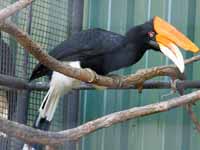
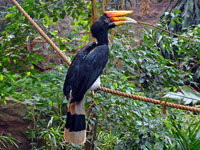
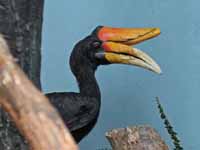

Hornbill,_Rufous Buceros hydrocorax
Description: The rufous hornbill has a rufous head and neck. The tail is off-white and may be stained. The rest of the plumage is black or brown. The bill and casque are red with a black base. The male has red or bluish eyes and the female has white eyes. It is 60 to 65 cm long and weighs about 1500 grams.
Range: Philippines.
Habitat: Mainly primary evergreen forest; also selectively looged forests.
Diet: Not well known.
Conservation status: It is listed as Vulnerable because of deforestation.
Image by:
1) Frank Wouters 2) Fiorellino 3) Magalhaes 4) NCAA_Official Olaf_Oliviero_RiemerRange: Philippines.
Habitat: Mainly primary evergreen forest; also selectively looged forests.
Diet: Not well known.
Conservation status: It is listed as Vulnerable because of deforestation.
1) Juvenile 2, 3) Female 4, 5) Male
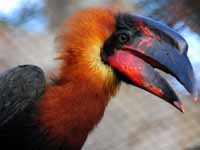
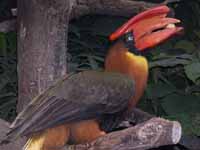
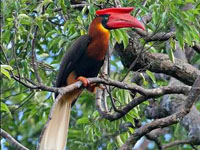
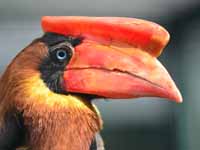
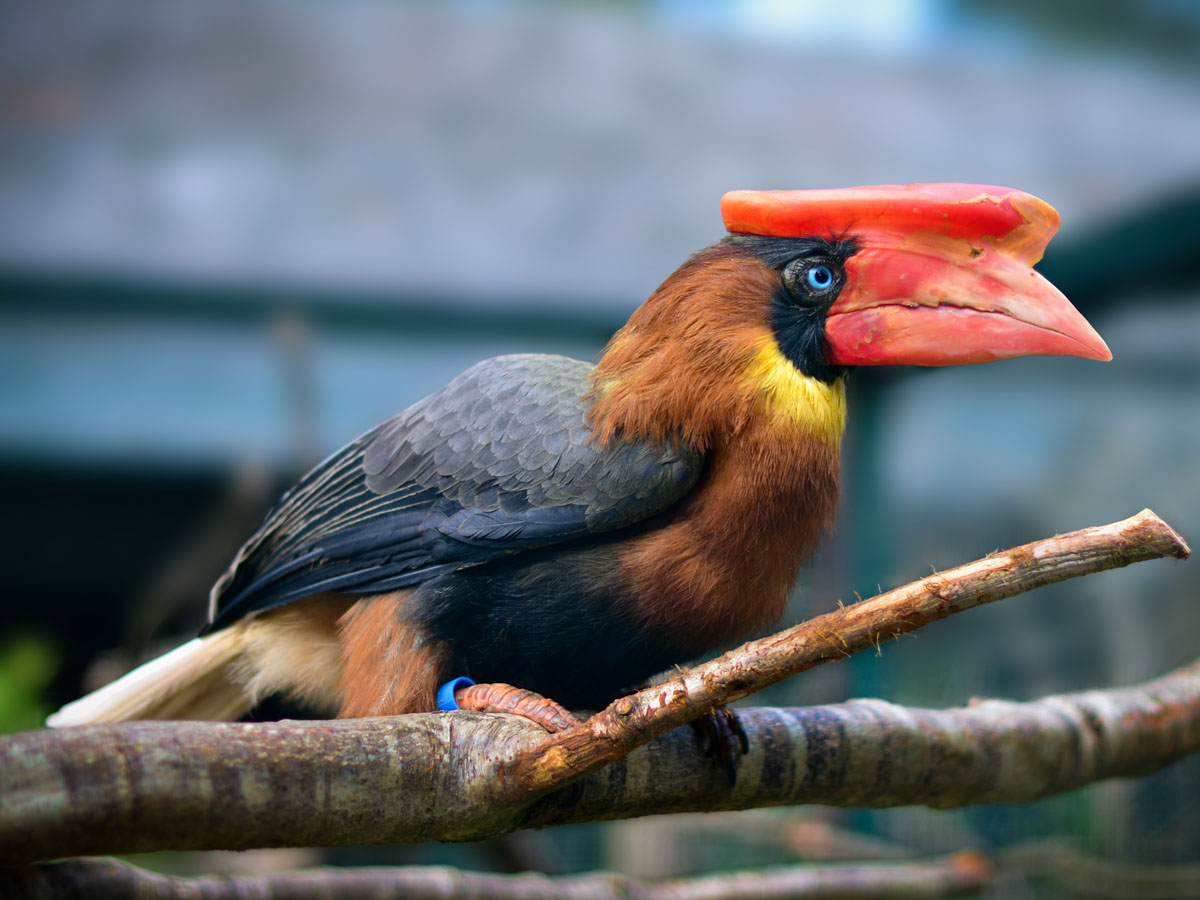
Genus Bycanistes
The African hornbills have black and white plumage. The plumage of the sexes is similar, but the casque of the male is larger than that of the female. They have often been included in the genus Ceratogymna,
Hornbill,_Black-and-white-casqued Bycanistes subcylindricus
Description: The black-and-white-casqued hornbill. also known as the grey-cheeked hornbill, has mainly black plumage. The lower back is white, The under-tail is white with a black band; the upper-tail is mainly black with some white. The male has a much larger casque than the female. They are 60 to 70 cm long, male weighs about 1.25 kg, and female 1.12 kg.
Range: Central Africa.
Habitat: Forests that are not dense, deciduous woodlands, plantations.
Diet: Mainly fruit; also insects, snails, lizards, bats.
Conservation status: Least Concern.
Image by: 1, 3) Nik_Borrow - Uganda 2) Bernard_Dupont 4)
Dante Alighieri - Bronx ZooRange: Central Africa.
Habitat: Forests that are not dense, deciduous woodlands, plantations.
Diet: Mainly fruit; also insects, snails, lizards, bats.
Conservation status: Least Concern.
1, 2) Female 3, 4) Male
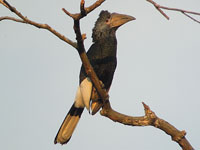
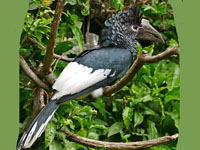
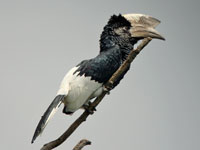
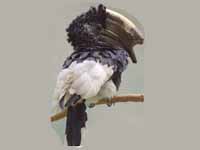
Hornbill,_Brown-cheeked Bycanistes cylindricus
Description: The brown-cheeked hornbill has mainly black plumage, a white belly, white tail with black median band, and the wing feathers are white tipped. The brown on the cheeks is difficult to observe. It is 60 to 70 cm long.
Range: West central Africa.
Habitat: Deciduous or mixed forests.
Diet: Fruit; also insects which it catches on the wing.
Conservation status: It is listed as Vulnerable and is one of the most threatened African hornbill. The main reason for its decline is deforestation duie to expanding agriculture and human population.
Image by:
1) John Gerrard Keulemans 2) Dimitry_Naumenko 3) Hans Olofsson - Uganda 4) Nik_Borrow - GhanaRange: West central Africa.
Habitat: Deciduous or mixed forests.
Diet: Fruit; also insects which it catches on the wing.
Conservation status: It is listed as Vulnerable and is one of the most threatened African hornbill. The main reason for its decline is deforestation duie to expanding agriculture and human population.



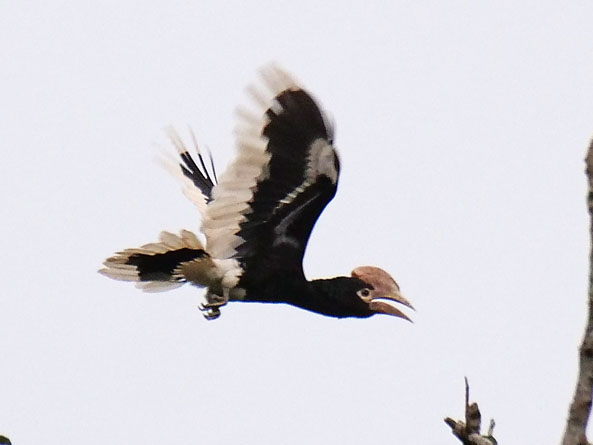
Hornbill,_Piping Bycanistes fistulator
Description: The piping hornbill has black upperparts, head, and breast. It has a white belly, under-wing secondaries, and rump, The grey casque is smaller for females. There is black skin around the eye. The similar trumpeter hornbill has has pink skin around eye. It is a smallish hornbill with a length of 45 cm, females average 450 grams, and the male 580 g.
Range: West central Africa.
Habitat: Primary forest and forest edges. Also mangroves, secondary forest, oil-palm plantations.
Diet: Mostly fruit; also some insects.
Conservation status: Least Concern.
Image by: 1) Dick Daniels - World of Birds
, South Africa 2) Moni Sertel 3) Dotun55 - NigeriaRange: West central Africa.
Habitat: Primary forest and forest edges. Also mangroves, secondary forest, oil-palm plantations.
Diet: Mostly fruit; also some insects.
Conservation status: Least Concern.

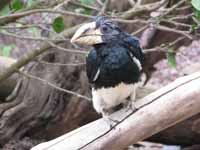
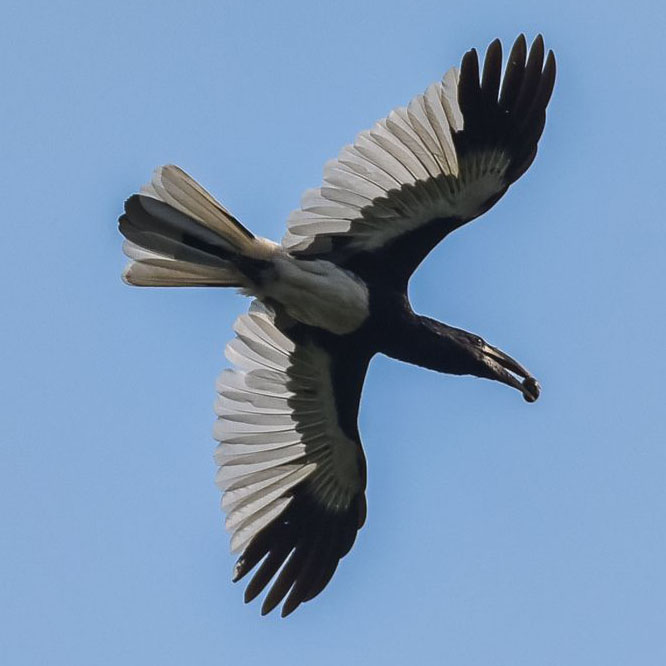
Hornbill,_Silvery-cheeked Bycanistes brevis
Description: The silvery-cheeked hornbill has a black upper-back, head, breast, and upper-belly. The face has a silvery-grey tint. It has a white lower-back, rump, and lower part of the under-tail. The female has a smaller casque on the bill and a reddish eye-ring. It is 60 to 70 cm long, female weighs about 1250 grams, and the male about 1330 g. The silvery-cheeked hornbil has more white on its upperparts than the similar trumpeter hornbill.
Range: East Africa from Ethiopia to South Africa.
Habitat: Tall evergreen forests.
Diet: Fruits, insects, small birds, rodents, small reptiles and centipedes.
Conservation status: Least Concern.
Image by: 1) Katy Silberger 2, 3) Dick Daniels - Sylvan Heights 4) Nik_Borrow - TanzaniaRange: East Africa from Ethiopia to South Africa.
Habitat: Tall evergreen forests.
Diet: Fruits, insects, small birds, rodents, small reptiles and centipedes.
Conservation status: Least Concern.
1) Female 2 - 4) Male

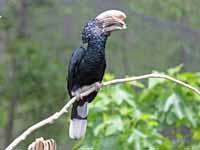
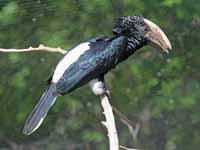
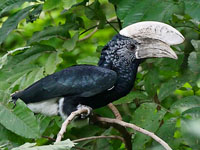
Hornbill,_Trumpeter Bycanistes bucinator
Description: The trumpeter hornbill has black upperparts, head, and breast. It has a white belly, under-wing coverts, and rump. There is pink skin around the eye. The grey casque is smaller for females. They are 58 to 65 cm long. The similar silvery-cheeked hornbill has much less white on its upperparts than the trumpeter hornbill.
Range: Southern half of Africa.
Habitat: Evergreen forests, some tall deciduous forests, and wooded hillsides.
Diet: Fruits. Also insects, small birds, crabs.
Conservation status: Least Concern.
Image by: 1) Dick Daniels - World of Birds, South Africa 2) Eric_Kilby 3) Ian White 4) Lip Kee - BotswanaRange: Southern half of Africa.
Habitat: Evergreen forests, some tall deciduous forests, and wooded hillsides.
Diet: Fruits. Also insects, small birds, crabs.
Conservation status: Least Concern.
1) Female 2, 3, 4) Male
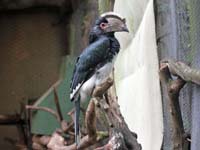

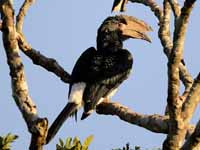

Hornbill,_White-thighed Bycanistes albotibialis
Description: The white-thighed hornbill has the top half of its body black. including the head. The lower half is white except for a black band on the white tail. It is 60 to 70 cm long, the male about 1300 grams and the female 975 g.
Range: Central Africa.
Habitat: Evergreen and semi-deciduous rainforest.
Diet: Mainly fruit. Also insects, chicks, eggs.
Conservation status: Least Concern.
Image by:
1) John Gerrard Keulemans 2) Sergey_Pisarevskiy - Uganda 3) Nik_Borrow - UgandaRange: Central Africa.
Habitat: Evergreen and semi-deciduous rainforest.
Diet: Mainly fruit. Also insects, chicks, eggs.
Conservation status: Least Concern.
3) Pair

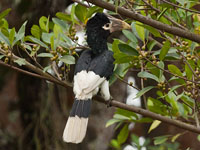
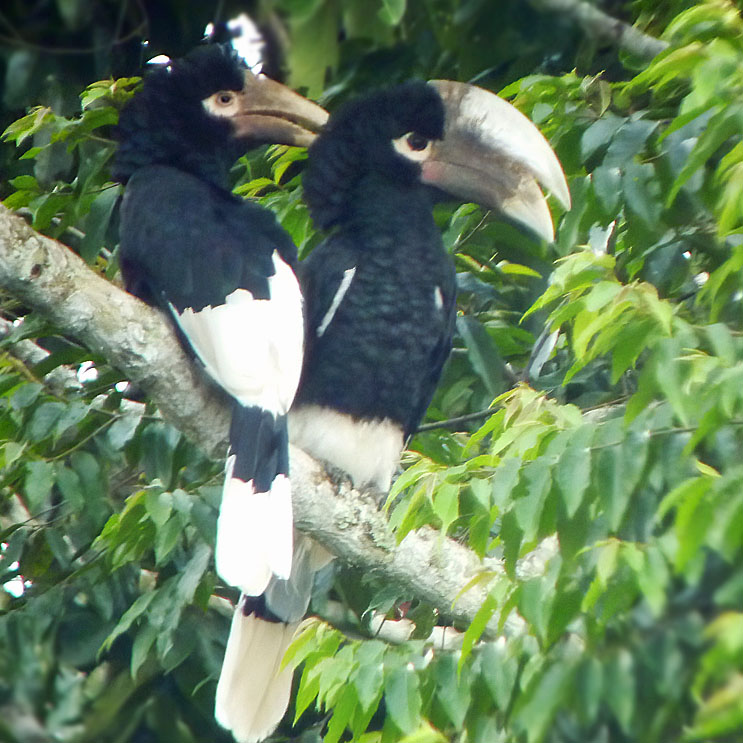
Genus Ceratogymna
Hornbill,_Black-casqued Ceratogymna atrata
Description: The black-casqued hornbill has mainly black plumage, blue facial skin, blue dewlap (bib), and some white on the lower-tail. The male has a black head; fthe emale has a brown head. It is 60 to 70 cm long, male weighs about 1300 grams, female 1050 grams
Range: Central Africa.
Habitat: Tropical rainforest.
Diet: Mainly fruit; also insects and occasionally crabs.
Conservation status: Least Concern.
Image by: 1) Daderot 2) Nik_Borrow - Ghana 3) Josh_MoreRange: Central Africa.
Habitat: Tropical rainforest.
Diet: Mainly fruit; also insects and occasionally crabs.
Conservation status: Least Concern.
1) Pair 2) Female 3) Male
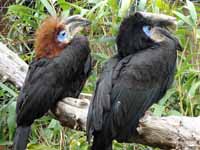
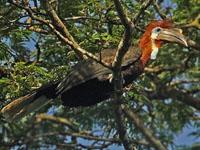
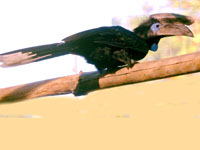
Hornbill,_Yellow-casqued Ceratogymna elata
Description: The yellow-casqued hornbill has mainly black plumage. It has a scaly neck pattern. The male has a black crown and mane; the female's is similar except it is red. This is one of the largest birds of the West African forest, with adults weighing up to 2 kg (4.4 lb).
Range: Coastal regions of west Africa.
Habitat: Rainforest, mainlhy in the forest canopy.
Diet: Mainly fruit, especially from oil palms. Also insects.
Conservation status: It is listed as Vulnerable due to destruction of forests.
1) Female 2) Male
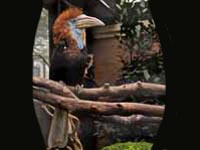
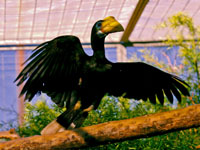
Genus Horizocerus
Hornbill,_Black_Dwarf Horizocerus hartlaubi
Description: The black dwarf hornbill has black upperparts including the head which has a broad white supercilium. The male's bill is black with a red tip while the female's bill is all black. The underparts are light grey with same wavy dark bars. It is the smallest hornbill with a length of 32 grams, female 90 grams, and male 115 grams.
Range: Central Africa.
Habitat: High in the canopy of tall trees which are usually evergreen.
Diet: Beetles, grasshoppers, locusts, caterpillars, spiders, lizards. Rarely fruit.
Conservation status: Least Concern.
Image by: 1) Daniel Giraud Elliot 2) Nik_Borrow - GhanaRange: Central Africa.
Habitat: High in the canopy of tall trees which are usually evergreen.
Diet: Beetles, grasshoppers, locusts, caterpillars, spiders, lizards. Rarely fruit.
Conservation status: Least Concern.
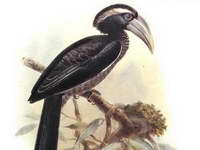
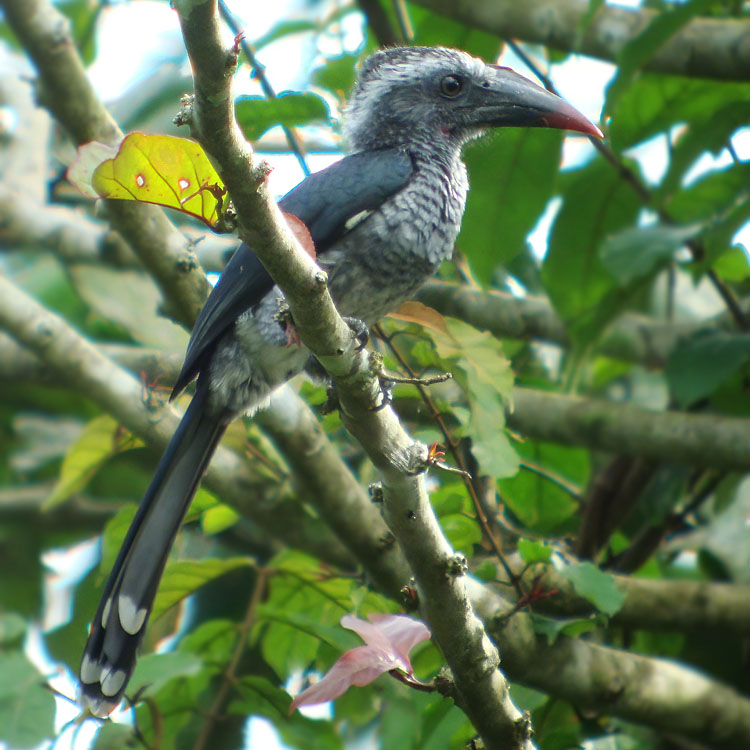
Hornbill, White-crested also Horizocerus albocristatus
Description: The white-crested hornbill, also known as the long-tailed hornbill, has mainly black plumage. It has a bushy white head and crest. Its bill and casque are blackish and the lower mandible has a cream patch near its base. It has a dark eye with a blackish patch around it. The tail is very long and graduated with white tips. It is 70 to 80 cm long, but the tail makes it seem longer than it is. The maleweighs about 290 grams and the female 280 g.
Range: Central Africa from Guinea to Nigeria and Western Africa from Nigeria to Angola.
Habitat: Primary forests, tall secondary forests, and adjacent woodlands.
Diet: Probably similar to black dwarf hornbill: beetles, grasshoppers, locusts, caterpillars, spiders, lizards. Also fruit, especially the oil palms.
Conservation status: Least Concern.
Image by: 1) Sandy Cole - San Diego Zoo 2, 4) Dick Daniels - Bronx Zoo, San Diego Zoo 3) Charlie WesterinenRange: Central Africa from Guinea to Nigeria and Western Africa from Nigeria to Angola.
Habitat: Primary forests, tall secondary forests, and adjacent woodlands.
Diet: Probably similar to black dwarf hornbill: beetles, grasshoppers, locusts, caterpillars, spiders, lizards. Also fruit, especially the oil palms.
Conservation status: Least Concern.


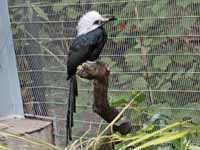
Genus Lophoceros
These hornbills are all native to Africa. They are small hornbills, about 50 cm in length.
Hornbill,_African_Pied Lophoceros fasciatus
Description: The African pied hornbill has black upperparts and upper-breast. It has a white lower-breast and belly. The bill and casque are black-and-yellow and the bill has a black tip. It is 45 to 50 cm long. When the chicks and the female are too big to fit in the nest, the mother breaks out and rebuilds the wall. Then both parents feed the chicks.
Range: Central Africa.
Habitat: Lowland forest, either evergreen or deciduous, Also oil palm plantations.
Diet: Fruits, insects.
Conservation status: Least Concern.
Image by: 1) Nik Borrow - Guinea 2, 4) Matti_Suopajärvi - Gambia 3) Anneli
Moeller Range: Central Africa.
Habitat: Lowland forest, either evergreen or deciduous, Also oil palm plantations.
Diet: Fruits, insects.
Conservation status: Least Concern.
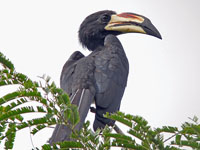
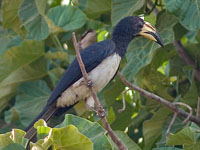
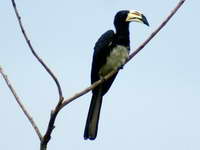
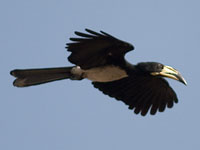
Hornbill,_Bradfield's Lophoceros bradfieldi
Description: The Bradfield's hornbill has pale brown upperparts, head, and upper-breast. The lower-breast and belly are white, eyes are yellow, bill is red, and thre is negligible casque. It is about 53 cm long. While the chicks are still young, the female emerges from the sealed nesting cavity to help the male deliver food.
Range: Southern Africe in Namibia, Botswana, Angola and Zimbabwe.
Habitat: Range of areas with tall trees.
Diet: Beetle, termites, ants, maggots. Also seeds, fruit, frogs.
Conservation status: Least Concern.
Image by: 1) Ron_Knight 2) Charlie Westerinen - Hwange National Park in Zimbabwe 3) Ian White - BotswanaRange: Southern Africe in Namibia, Botswana, Angola and Zimbabwe.
Habitat: Range of areas with tall trees.
Diet: Beetle, termites, ants, maggots. Also seeds, fruit, frogs.
Conservation status: Least Concern.
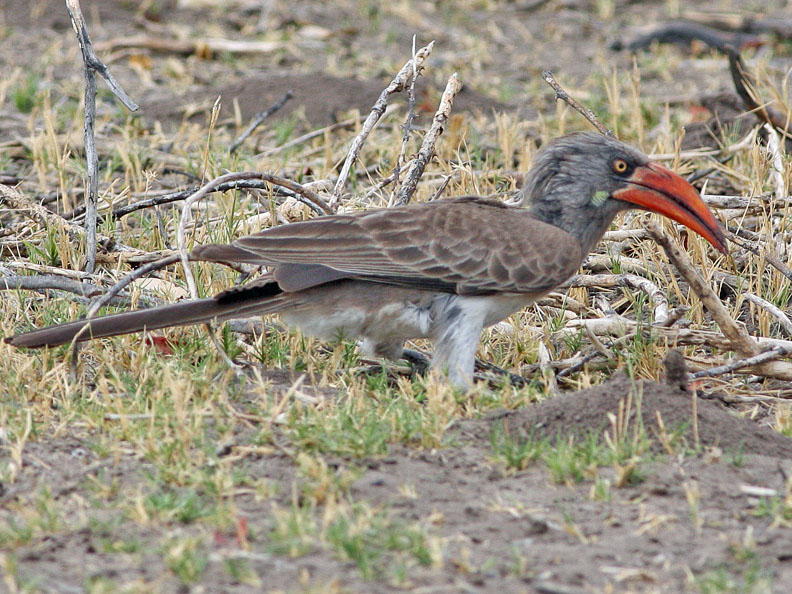
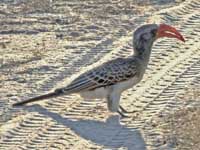

Hornbill,_Crowned Lophoceros alboterminatus
Description: The crowned hornbill has black upperparts, head, and upper-breast. It has a white lower-breast and belly plus it has a pale under-tail. The bill and casque are red and the eyes are yellow. There is white at the base of its bill. It is about 50 cm long and weighs about 250 grams which makes it a small hornbill. The female exits the sealed nest cavity about a month after the first egg hatches so that she can assist the male in feeding the brood.
Range: Equatorial Africa and south.
Habitat: Forests containing tall trees with cavities suitable for nesting.
Diet: Mainly fruit during the dry season. Otherwise fruit, insects, snails, small birds, lizards.
Conservation status: Least Concern.
Image by: 1) Bernard_Dupont - South Africa 2) Derek Keats 3) Sergey_Yeliseev 4) Nik_Borrow - UgandaRange: Equatorial Africa and south.
Habitat: Forests containing tall trees with cavities suitable for nesting.
Diet: Mainly fruit during the dry season. Otherwise fruit, insects, snails, small birds, lizards.
Conservation status: Least Concern.
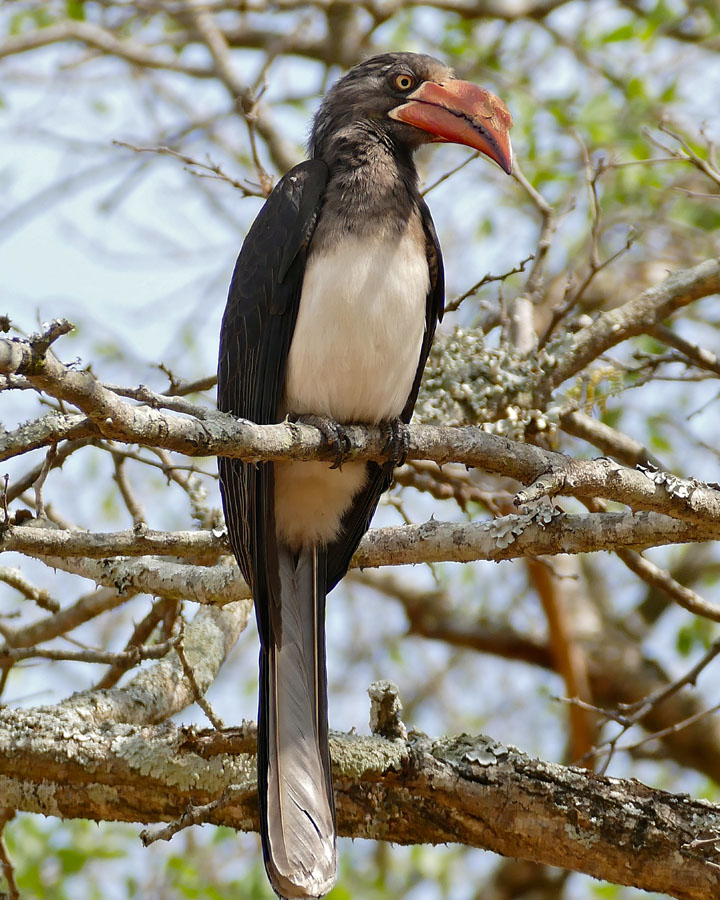
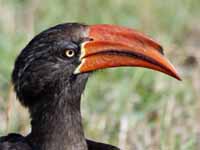
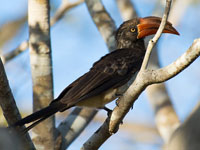
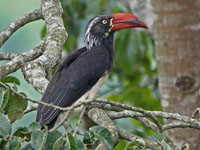
Hornbill,_African grey Lophoceros nasutus
Description: The African grey hornbill has mainly grey plumage. The head, tail, and flight feathers are darker. There is a white line down each side of head which merge and may continue down the back. The adult has a small casque while the juvenile has none. The male has a black bill, whereas the female has some yellow on the upper mandible. This is a small hornbill with a length or 45 to 52 cm, male weighing 170 to 260 grams, and the female 160 to 220 g. It will nest in a tree cavity, rock pile, or in the ground. Per usual for hornbills, the female is sealed into the cavity to lay the eggs, incubate, and later emerge to help feed the chicks.
Range: Sub-Saharan Africa.
Habitat: Open savanna. Also deciduous woodland to dense woods.
Diet: Mainly insects such as grasshoppers and beetles. Also tree frogs, lizards, small birds and some fruit.
Conservation status: It is listed as Least Concern. Its population is doing well since tall cavity trees are not essential for a nest site and a diet mainly of insects is usually readily avaiable.
Image by: 1) Dominic_Sherony 2, 3) Charles_J_Sharp - Namibia, Gambia 4) Nik_BorrowRange: Sub-Saharan Africa.
Habitat: Open savanna. Also deciduous woodland to dense woods.
Diet: Mainly insects such as grasshoppers and beetles. Also tree frogs, lizards, small birds and some fruit.
Conservation status: It is listed as Least Concern. Its population is doing well since tall cavity trees are not essential for a nest site and a diet mainly of insects is usually readily avaiable.
1, 2) Female 3, 4) Male
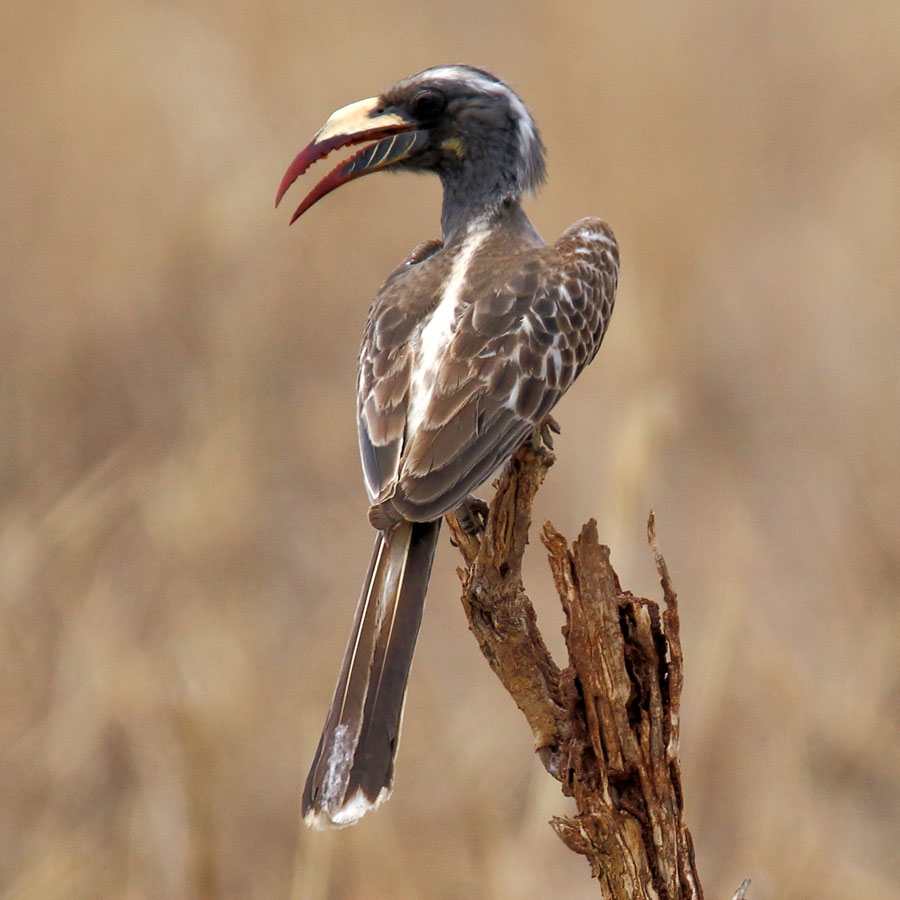
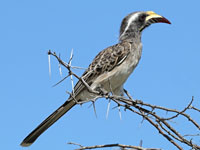
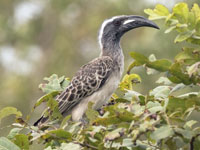
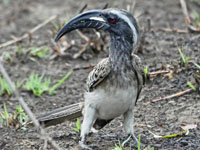
Hornbill,_Hemprich's Lophoceros hemprichii
Description: The Hemprich's hornbill has dark brown upperparts and mostly white underparts. The under-tail is mostly dark with a couple of white feathers. It is a relatively small hornbill with a length of 50 to 58 cm.
Range: Equatorial eastern Africa - Djibouti, Eritrea, Ethiopia, Kenya, Somalia, South Sudan, and Uganda.
Habitat: Hilly wooded areas near moving water.
Diet: Mainly insects. Also lizards, chameleons, fruit.
Conservation status: Least Concern.
Image by: 1) Steve Evans Ethopia 2) Alastair Rae 3) Michael and Helen Cox - KenyaRange: Equatorial eastern Africa - Djibouti, Eritrea, Ethiopia, Kenya, Somalia, South Sudan, and Uganda.
Habitat: Hilly wooded areas near moving water.
Diet: Mainly insects. Also lizards, chameleons, fruit.
Conservation status: Least Concern.
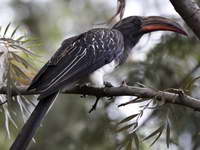
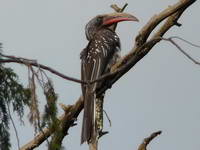
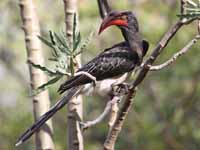
Hornbill,_Pale-billed Lophoceros pallidirostris
Description: The pale-billed hornbill has grey and brown upperparts with pale edges to the feathers. It has a white supercilium and white underparts. The bill is yellow with a small casque. It is a small hornbill with a length of 43-50 cm, male weight of 250 to 325 grams, and female weight of 170 to 220 g.
Range: Angola, DRC, Kenya, Malawi, Mozambique, Tanzania, and Zambia.
Habitat: Tall deciduous woodland.
Diet: Probably eats mainly insects.
Conservation status: Least Concern.
Image by:
1) Peter_Steward - Malawi 2, 3, 4) Nik_Borrow - Malawi, Malawi, TanzaniaRange: Angola, DRC, Kenya, Malawi, Mozambique, Tanzania, and Zambia.
Habitat: Tall deciduous woodland.
Diet: Probably eats mainly insects.
Conservation status: Least Concern.
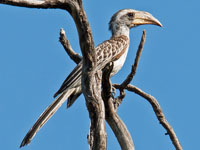
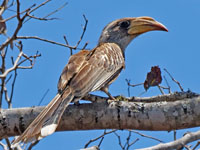
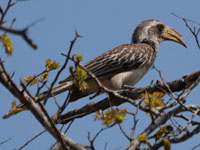

Genus Ocyceros
These relatively small hornbills are found either in India or the neiighboring island of Sri Lanka. They have grey plumage and either small or nonexistant casques.
Hornbill,_Indian_grey Ocyceros birostris
Description: The Indian grey hornbill has greyish-brown upperparts, a darker face, pale underparts, and white thighs. The casque is short and pointed. The tail has a white tip and a dark subterminal band. At 55 cm of length it is a relatively small hornbill.
Range: Indian subcontinent.
Habitat: Deciduous woodlands, scattered fig trees.
Diet: Fruit, especially figs. Also insects, lizards, chicks.
Conservation status: Least Concern.
Image by: 1) J M Garg -
Hyderabad, India 2) Raju_Kasambe 3) Tarique_Sani 4)
photosinframesRange: Indian subcontinent.
Habitat: Deciduous woodlands, scattered fig trees.
Diet: Fruit, especially figs. Also insects, lizards, chicks.
Conservation status: Least Concern.
2) Male supplying food to nest inmates
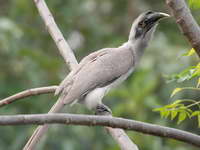
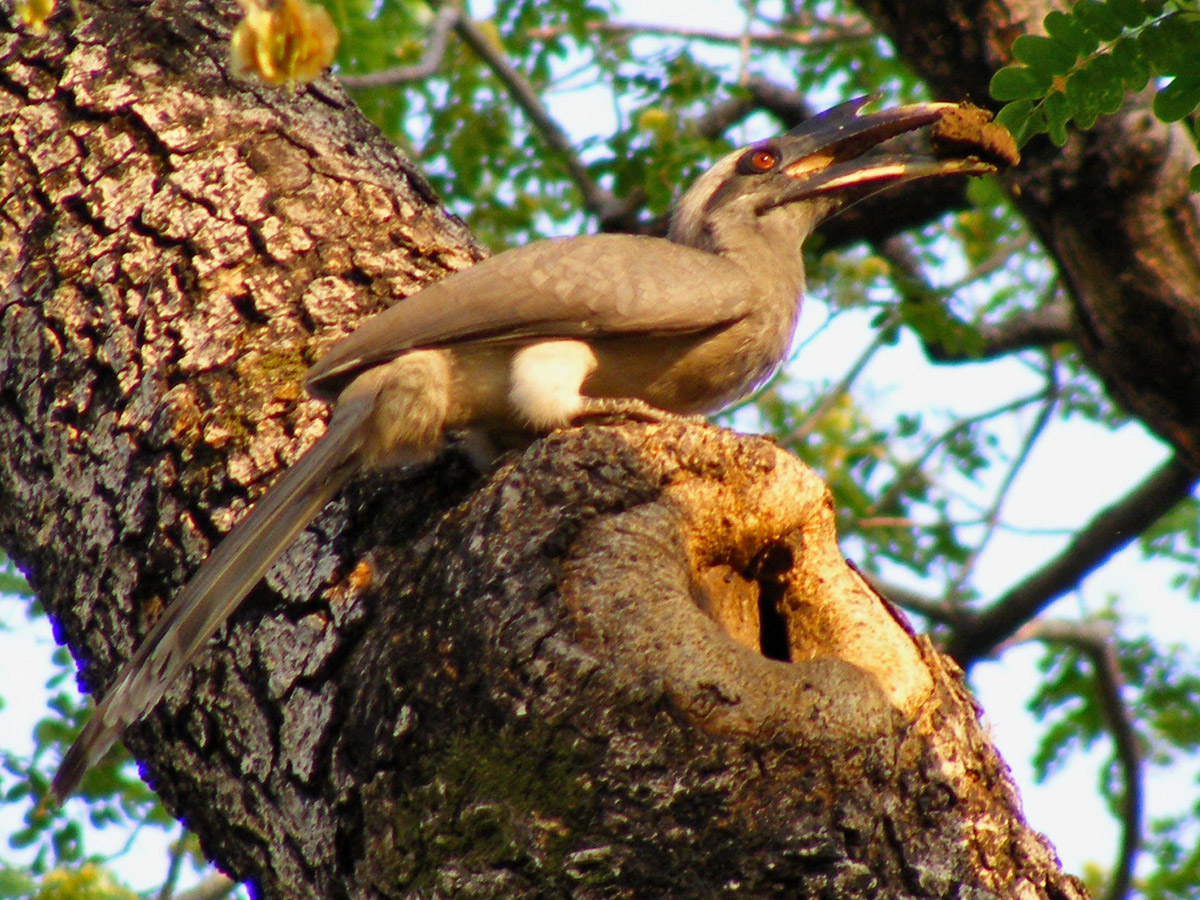


Hornbill,_Malabar_grey Ocyceros griseus
Description: The Malabar grey hornbill has a grey back, lighter grey underparts, brown-grey wings, cinnamon vent,and a broad whitish superciliary band above the eye which continues to the neck. The male has a reddish bill with a yellow tip. The female has a yellow bill with black at the base of the lower mandible. The Malabar grey hornbill does not have a casque. It is the smallest Oriental hornbill with a length of 34 to 47 cm.
Range: Southern India.
Habitat: Moist evergreen forests, gardens near forests.
Diet: Mainly fruit; also insects and small animals.
Conservation status: It is listed as Vulnerable because of forest degradation.
Image by: 1, 3) Lip Key 2) Rathika Ramasamy 4) Nagesh_KamathRange: Southern India.
Habitat: Moist evergreen forests, gardens near forests.
Diet: Mainly fruit; also insects and small animals.
Conservation status: It is listed as Vulnerable because of forest degradation.
1) Female 2, 3) Male
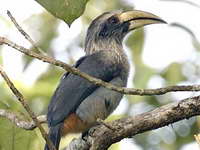
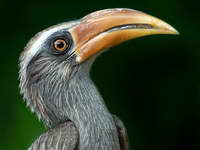


Hornbill,_Sri_Lanka_grey Ocyceros gingalensis
Description: The Sri Lanka grey hornbill has grey upperparts, a blackish tail with white sides, white underparts. It has grey wings with black primary feathers. The long curved bill has no casque. The male has a cream colored bill, female has black with cream stripe. It is 45 cm long and the male weighs about 240 grams which makes it a small hornbill.
Range: Sri Lanka.
Habitat: Forests; also plantations and large gardens.
Diet: Mainly fruit, especially figs. Also insects, frogs, lizards. Finds fruit in the foliage; perches lower when looking for prey.
Conservation status: Least Concern.
Image by: 1) Lahiru_Prabudd_Fernando 2) Rafael_Vila 3, 4) Gihan_JayaweeraRange: Sri Lanka.
Habitat: Forests; also plantations and large gardens.
Diet: Mainly fruit, especially figs. Also insects, frogs, lizards. Finds fruit in the foliage; perches lower when looking for prey.
Conservation status: Least Concern.
1) Female 2 - 4) Male
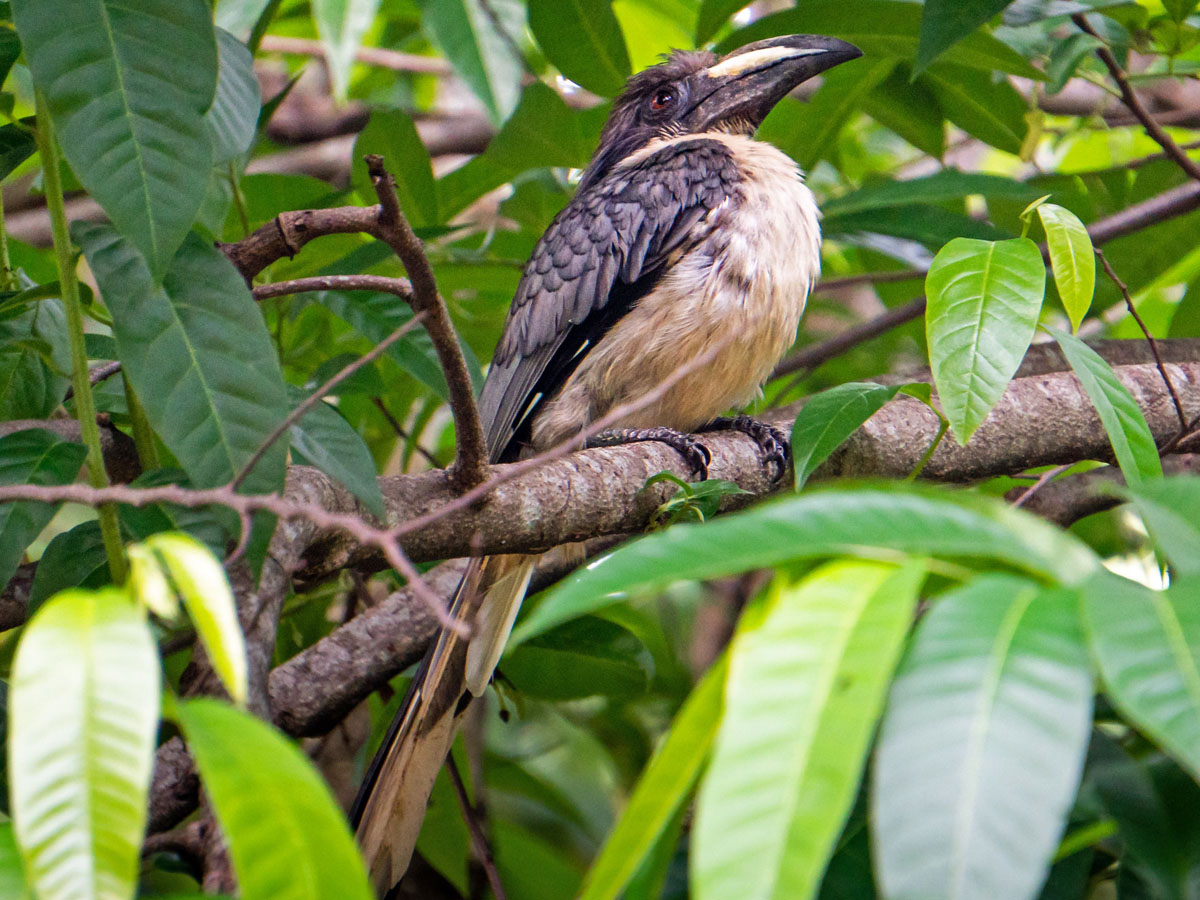
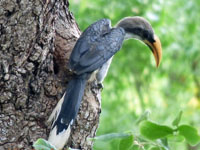

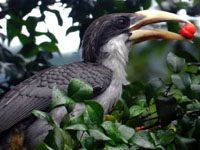
Genus Penelopides
Hornbill,_Luzon Penelopides manillae Found: Philippines
The male Luzon hornbill has dark brown upperparts and wings. The dark brown tail has a pale band. It has a white head with balck ear coverts. The underparts are white. The smaller female has black upperparts, brown underparts, and it has blue orbital skin around the eye. It is 45 cm long and weighs about 450 grams.
Description:
Range: Luzon and nearby islands in the northern Philippines.
Habitat: Mainly evergreen forests, but will even visit isolated fruit tree.
Diet: Fruits, especially figs. Probably also insects and small animals.
Conservation status: Least Concern.
Image by: 1) Mark A Harper 2) Len_Worthington 3) BS Thurner Hof Description:
Range: Luzon and nearby islands in the northern Philippines.
Habitat: Mainly evergreen forests, but will even visit isolated fruit tree.
Diet: Fruits, especially figs. Probably also insects and small animals.
Conservation status: Least Concern.
1) Female 2, 3) Male

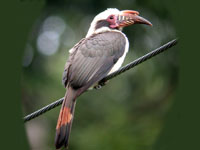
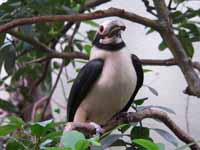
Hornbill,_Mindanao Penelopides affinis Found: Philippines
Description: The male Mindanao hornbill has black upperparts. The underparts and head are mostly white. It has black cheeks and the upper-throat is also black. It is the only black and white hornbill in its range. The female has mostly black plumage. The tail is pale orange with a black tip.
Range: Mindanao, Dinagat, Siargao and Basilan in the southern Philippines.
Habitat: Forest, forest edges and clearings.
Diet: Mainly fruit. Also seed, insects.
Conservation status: Least Concern.
Image by:
1) Berstein49 3) Blake Matheson 3) Jovic_FerrerRange: Mindanao, Dinagat, Siargao and Basilan in the southern Philippines.
Habitat: Forest, forest edges and clearings.
Diet: Mainly fruit. Also seed, insects.
Conservation status: Least Concern.
1) Female 2, 3) Male
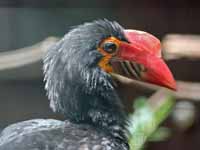
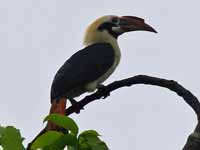
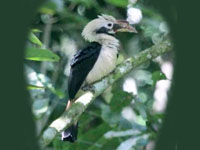
Hornbill,_Samar Penelopides samarensis Found: Philippines
Description: The Samar hornbill is also considered a subspecies of the Mindanao hornbill. The male has black upperparts. The underparts and head are mostly white. The female has mostly black plumage.
Range: Islands of Samar, Calicoan, Leyte and Bohol in the east-central Philippines.
Habitat: Forest, clearings and isolated fruit trees.
Diet: Mainly fruit. Also seeds and small animals.
Conservation status: Least Concern.
Image by: 1) Sergey_YeliseevRange: Islands of Samar, Calicoan, Leyte and Bohol in the east-central Philippines.
Habitat: Forest, clearings and isolated fruit trees.
Diet: Mainly fruit. Also seeds and small animals.
Conservation status: Least Concern.
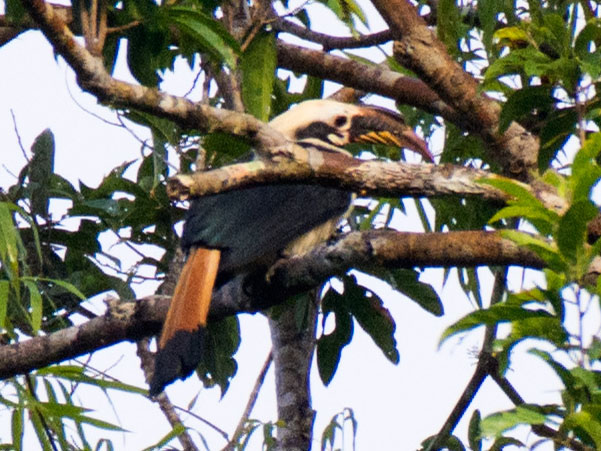
Hornbill,_Visayan Penelopides panini Found: Philippines
Description: The male Visayan hornbill has black upperparts. It has a creamy-white head and neck, a whitish breast, and a creamy-white tail with a broad black tip. The bill is blackish with yellow ridges and a small black casque. There is pinkish-white ocular skin around the eyes. The female has mainly black plumage, a blackish bill with yellow ridges, a black casque, and bluish ocular skin.
Range: Islands of Panay, Negros, Masbate, and Guimaras, in the Philippines.
Habitat: Canopy of rainforests.
Diet: Mainly fruit. also insects.
Conservation status: It is listed as Endangered because of forest destruction.
Image by: 1) Magalhães 2) Nasser_Halaweh 3) Steven_Wilson 4) Tim Ellis - Chester Zoo Range: Islands of Panay, Negros, Masbate, and Guimaras, in the Philippines.
Habitat: Canopy of rainforests.
Diet: Mainly fruit. also insects.
Conservation status: It is listed as Endangered because of forest destruction.
1, 2) Pair 3, 4) Male
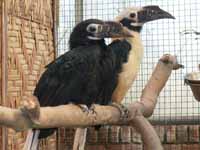

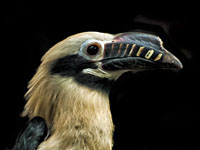
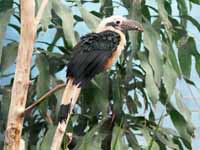
Genus Rhabdotorrhinus
Hornbill,_Sulawesi Rhabdotorrhinus exarhatus Found: Indonesia
Description: The male Sulawesi hornbill, also known as the Sulawesi tarictic hornbill, has mainly black plumage, a yellow face, and a yellow throat. The female has all black plumage. It usually nests in a cavity of a living deciduous tree. It lives in groups of up to 20. The female is usuallly sealed in the cavity for about 3 months during which the male and helpers brings regurgitated food to the inmates. It is a small hornbill with a length of 45 cm.
Range: Indonesian island of Sulawesi and nearby islands.
Habitat: Tropical lowland, swamps and primary forests.
Diet: It eats mainly fruit, especially figs. Also insects.
Conservation status: It is listed as Vulnerable because of forest degradation and hunting.
Image by: 1) Vachovec1 2) Chris
huh 3) TR_Shankar_RamanRange: Indonesian island of Sulawesi and nearby islands.
Habitat: Tropical lowland, swamps and primary forests.
Diet: It eats mainly fruit, especially figs. Also insects.
Conservation status: It is listed as Vulnerable because of forest degradation and hunting.
1) Pair 2, 3) Male

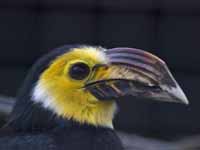
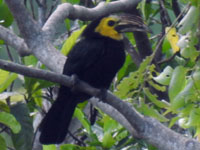
Hornbill,_Walden's Rhabdotorrhinus waldeni
Description: The Walden's hornbill, also known as the writhe-billed hornbill, has mainly black plumage. The male has a pale yellow throat and pale yellow ocular skin around the eyes, Yellow is replace dby blue for the female. It is 60 to 65 cm in length.
Range: Islands of Negros and Panay in the Philippines.
Habitat: Prefers evegreen forests with closed canopy, but will even frequest individual fruit trees.
Diet: Mainly fruit.
Conservation status: It is listed as Critically Endangered because of hunting and deforestation which not only reduces its fruit trees but all potential nesting trees.
Image by:
1) Prof. Curio 2, 3) Callen BentleyRange: Islands of Negros and Panay in the Philippines.
Habitat: Prefers evegreen forests with closed canopy, but will even frequest individual fruit trees.
Diet: Mainly fruit.
Conservation status: It is listed as Critically Endangered because of hunting and deforestation which not only reduces its fruit trees but all potential nesting trees.
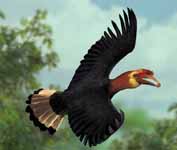
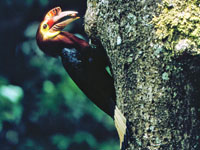
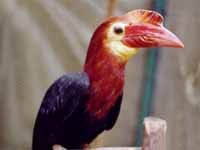
Hornbill,_Wrinkled Rhabdotorrhinus corrugatus Found: southeast Asia
Description: The wrinkled hornbill has mainly black plumage, a blue eye-ring, and a pale-tipped tail. The male has yellow cheeks, neck, and throat. He has a yellow bill with a red base and a red casque. The female has black cheeks, neck,and a blue throat. She has a yellow bill and casque. It is a large hornbill with a length of 65 to 70 cm. The female spends more than 3 months in a partially sealed cavity nest. She and the 2 to 3 chicks are fed regurgitated food by the male.
Range: Thailand, Malaysia, Sumatra, Borneo.
Habitat: Lowland evergreenf forest and selectively logged forests, but not secondary forests.
Diet: Lipid-rich fruits; also some figs.
Conservation status: It is listed as Critically Endangered because the population is declining since it requires large tracts of tall trees which are being removed via logging.
Image by: 1) Linda_De_Volder 2) Erik van Roekel 3) Tony_Castro 4) David_Cook - BorneoRange: Thailand, Malaysia, Sumatra, Borneo.
Habitat: Lowland evergreenf forest and selectively logged forests, but not secondary forests.
Diet: Lipid-rich fruits; also some figs.
Conservation status: It is listed as Critically Endangered because the population is declining since it requires large tracts of tall trees which are being removed via logging.
1) Female 2 - 4) Male

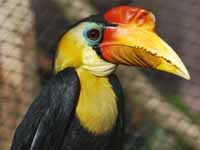
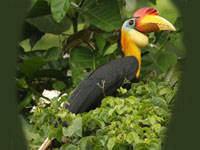
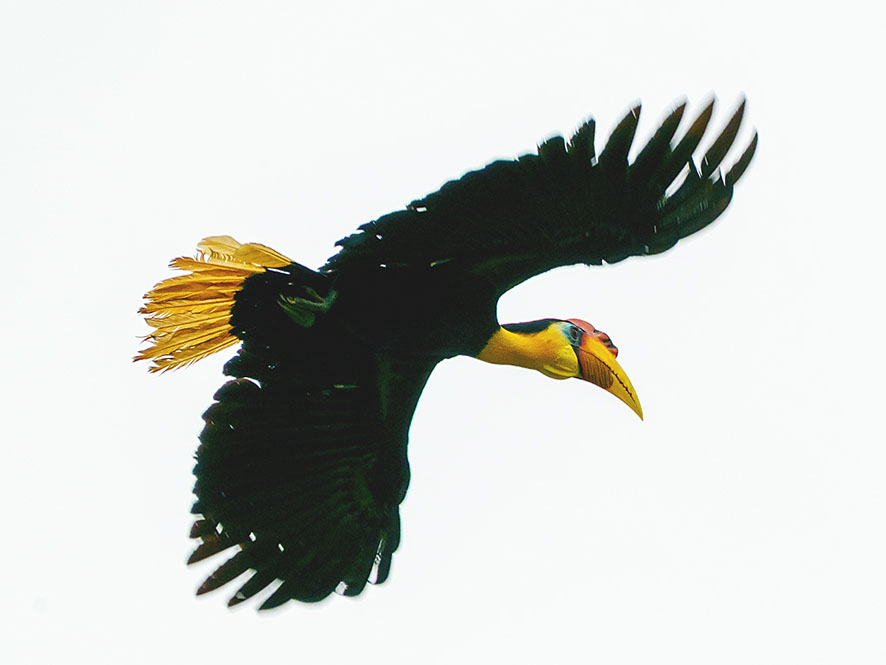
Hornbill,_Writhed Rhabdotorrhinus leucocephalus Found, Philippines
Description: The Writhed hornbill has mainly black plumage. The name "writhed" refers to its casque which is wrinkled. The bill and the casque are both wrinkled. It has an orange-red throat and ocular skin. The tail is white with a black tip. The male's neck to upper-breast is white while the similar plumage on the female is black. It is a medium-sized hornbill wth a length 60 to 65 cm.
Range: Mindanao of the Philippines and some close by islands.
Habitat: Humid primary evergreen forests.
Diet: Primary evergreen forests.
Conservation status: It is listed as Near Threatened because of forest reduction.
Image by: 1) John Gerrard Keulemans 2) Francesco Veronesi 3) Vanessa_David 3) Patricia CasterenRange: Mindanao of the Philippines and some close by islands.
Habitat: Humid primary evergreen forests.
Diet: Primary evergreen forests.
Conservation status: It is listed as Near Threatened because of forest reduction.
1) Male on left 2) Female 3) Male
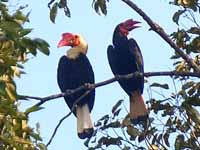
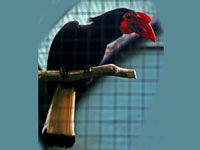

Genus Rhyticeros
These medium to large hornbills are found from Southeast Asia to the Solomons. They have low, wreathed (wrinkled) casques and a mostly dull whitish horn-colored bill. They have mainly black plumage and most have a white tail. They have inflatable skin on the throat, which is blue for most males. The head and neck of the males are white or rufous.
Hornbill,_Blyth's Rhyticeros plicatus
Description: The Blyth's hornbill, also known as the Papaun hornbill, has mainly black plumage. The male has a golden or orange-buff head, pale blue orbital skin, a white throat, and a white tail. The similar female has the golden/orange replaced by black. Both have a large bill and casque that are horn colored. It is a large hornbill with a length of 65 to 85 cm, weighing between 1200 and 2000 grams.
Range: New Guinea and nearby islands.
Habitat: Forests of various types.
Diet: Mainly fruit; also insects, crabs, honeycomb.
Conservation status: Least Concern.
Image by:
1) Cifor 2) yumievriwan 3) Stephen Hanafin 4) Jerry Oldenettel - Papua New GuineaRange: New Guinea and nearby islands.
Habitat: Forests of various types.
Diet: Mainly fruit; also insects, crabs, honeycomb.
Conservation status: Least Concern.
1, 2) Female 3) Male 4) Pair
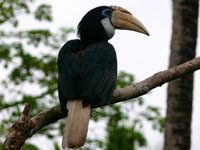
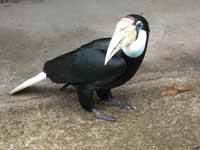
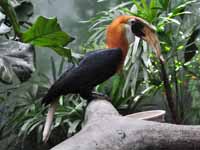
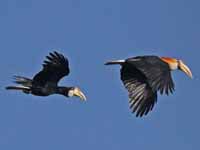
Hornbill,_Knobbed Rhyticeros cassidix
Description: The knobbed hornbill has a large casque (knob), mainly black plumage, and a blue and black throat. The male has a rufous/buff face and neck. The eyes are orange-red and the casque is reddish-orange eyes. The female has a black face and neck, a yellow casque, and brownish eyes.
Range: Indonesia, especially Sulawesi.
Habitat: Evergreen forests, woodlands, plantations.
Diet: Mainly fruit. These hornbills are an important disperser of seeds.
Conservation status: It is listed as Vulnerable as they depend on large mature trees for breeding.
Image by: 1) WarriorWoman 2) Mario Pineda - Los Angeles Zoo 3) Lip Kee - North Sulawesi 4) Asim_BharwaniRange: Indonesia, especially Sulawesi.
Habitat: Evergreen forests, woodlands, plantations.
Diet: Mainly fruit. These hornbills are an important disperser of seeds.
Conservation status: It is listed as Vulnerable as they depend on large mature trees for breeding.
1) Pair 2) Female 3, 4) Male
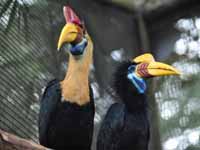
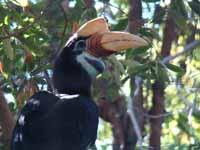
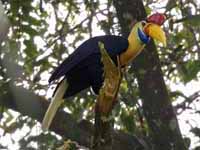
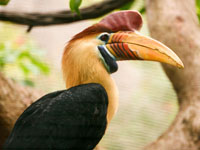
Hornbill,_Narcondam Rhyticeros narcondami Found: Indian island of Narcondam
Description: The male Narcondam hornbill has a rufous head and neck, a black body, orange-red eye, blue ocular skin, and a white tail. The female has black plumage, a bluish-white neck patch, a blue ocular skin, and a white tail. It is 66 cm in length.
Range: Indian island of Narcondam in the Andamans.
Habitat: Fairly open and mixed forests which fortunately cover much of the island.
Diet: Mainly fruit.
Conservation status: It is listed as Vulnerable. It the past goats have browed saplings. Cats may also be a problem. That said, the population may have now stabilized because of conservation efforts.
Image by: 1, 2) RohitjahnaviRange: Indian island of Narcondam in the Andamans.
Habitat: Fairly open and mixed forests which fortunately cover much of the island.
Diet: Mainly fruit.
Conservation status: It is listed as Vulnerable. It the past goats have browed saplings. Cats may also be a problem. That said, the population may have now stabilized because of conservation efforts.
1) Female 2) Male
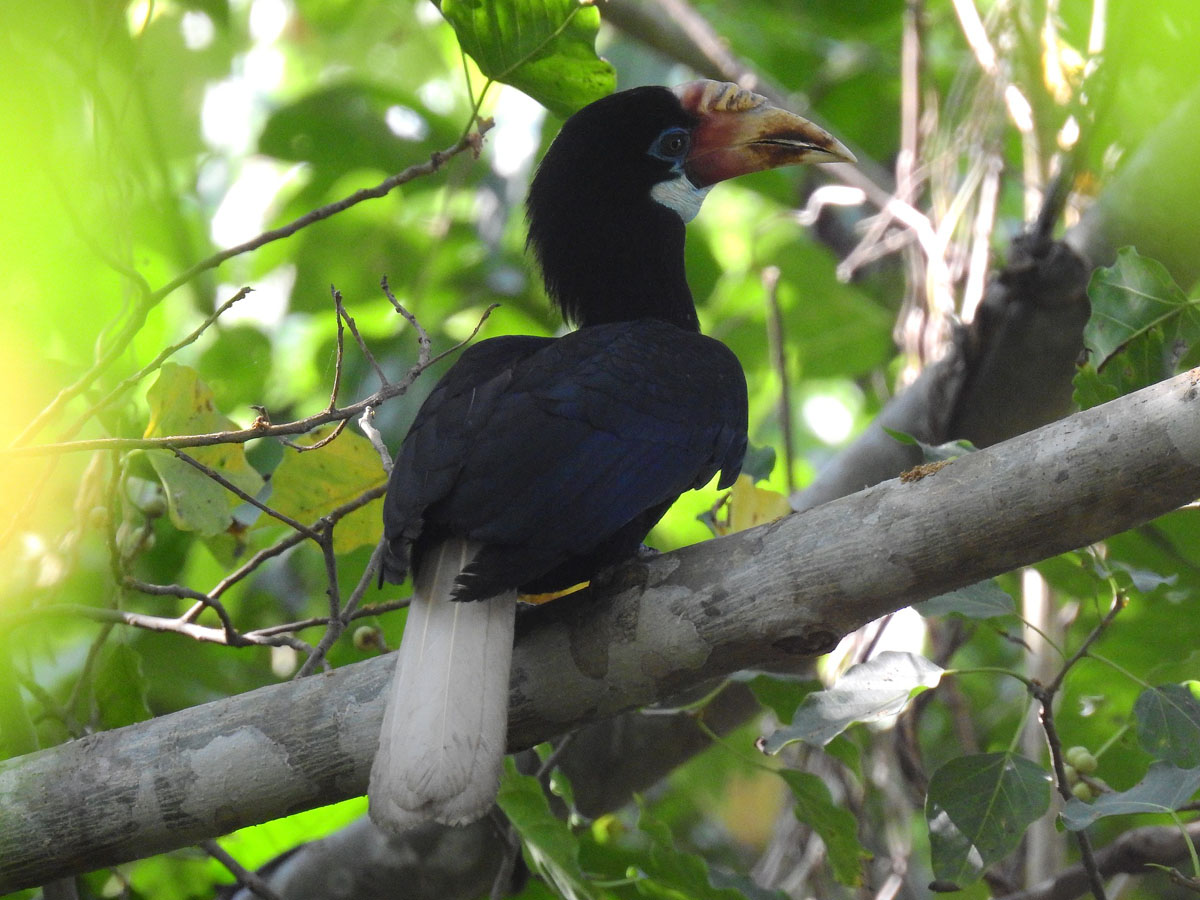

Hornbill,_Plain-pouched Rhyticeros subruficollis
Description: The plain-pouched hornbill has mainly black plumage. It has ivory colored bill and casque. The casque is small and wrinkled.The male hasan orange throat pouch and the female has a blue throat pouch and also blue orbital skin. The sides of the male head continuing down to the upper-breast is creamy-white. The similar female plumage is black. It is 65 to 70 cm long. The female of the similar wreathed hornbill does not have blue orbital skin around the eyes.
Range: Southeast Asia, Malaysia, Indonesia .
Habitat: Evergreen and mixed deciduous forests.
Diet: Mainly fruit; also some small animals.
Conservation status: It is listed as Vulnerable as it is negatively affected by deforestation and hunting.
Image by: 1) John Gerrard KeulemansRange: Southeast Asia, Malaysia, Indonesia .
Habitat: Evergreen and mixed deciduous forests.
Diet: Mainly fruit; also some small animals.
Conservation status: It is listed as Vulnerable as it is negatively affected by deforestation and hunting.

Hornbill,_Sumba Rhyticeros everetti
Description: The Sumba hornbill has mainly blackish plumage. It has a large yellowish bill with a maroon patch at the base. The casque is yellowish and brown. The male has a reddish-brown crown plus nape and the female hasa black crown plus nape. It is a small hornbill, 55 cm long.
Range: Sumba in Lesser Sunda Islands of Indonesia.
Habitat: Semi-evergreen forests.
Diet: Mainly fruit.
Conservation status: Due to ongoing habitat loss, limited range, small population size and overhunting in some areas, the Sumba hornbill is listed as Vulnerable.
Image by: 1) Stavenn Range: Sumba in Lesser Sunda Islands of Indonesia.
Habitat: Semi-evergreen forests.
Diet: Mainly fruit.
Conservation status: Due to ongoing habitat loss, limited range, small population size and overhunting in some areas, the Sumba hornbill is listed as Vulnerable.
1) Female
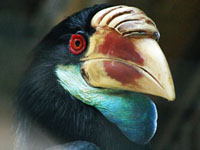
Hornbill,_Wreathed Rhyticeros undulatus
Description: The wreathed hornbill has mainly black plumage with a short white tail. The bill is pale yellow; the casque is small and pale yellow with brown wrinkles. The male has an orange throat pouch, female has blue throat pouch. It is a large hornbill 75 to 85 cm in length, male weighs 1680 to 3650 grams, and female weighs 1360 to 2685 g. It nests in large trees witha natural cavity, female seals entrance with droppings, lays 1 to 3, but only one fledges. The female is enclosed for almost 4 months.
Range: India, southeast Asia, Malaysia, Indonesia.
Habitat: Primary evergreen forest and selective logged forests.
Diet: Mainly fruit; also small animals.
Conservation status: The wreathed hornbill is listed as Vulnerable because of deforestation and hunting.
Image by:
1) Dick_Culbert 2) Sandy Cole 3) Dick Daniels - Sylvan Heights 4) Jerry Oldenettel - ThailandRange: India, southeast Asia, Malaysia, Indonesia.
Habitat: Primary evergreen forest and selective logged forests.
Diet: Mainly fruit; also small animals.
Conservation status: The wreathed hornbill is listed as Vulnerable because of deforestation and hunting.
1, 2) Female 3, 4) Male
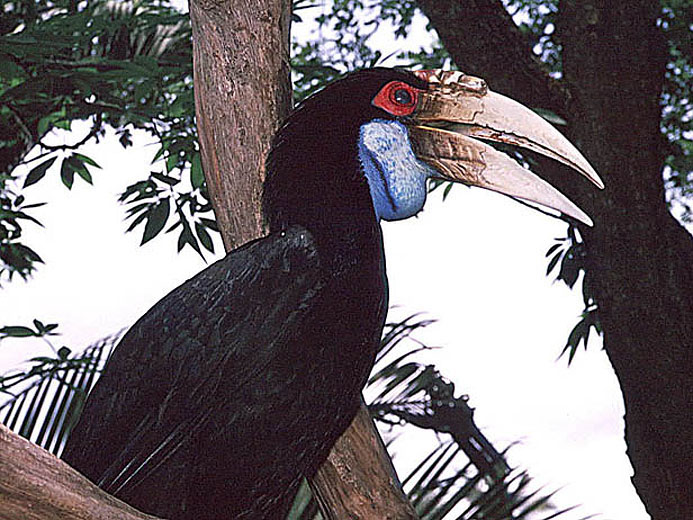


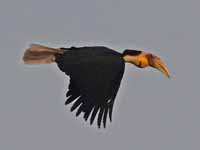
Genus Tockus
The hornbills in Lophoceros are close relatives and used to be include in genus tockus.
Hornbill,_Jackson's Tockus jacksoni
Description: The Jackson's hornbill has black upperparts with white spots. It has a white head with black cap and black eye-patch. The underparts are mainly white. The male has a red bill while the female has a black bill. There is a low casque. The similar Von der Decken's hornbill does not have white spots. It is a small hornbill with a length of 35 cm, male weighs 165 to 215 grams, and female weighs 120 ot 155 grams.
Range: Northwest Kenya and northeast Uganda.
Habitat: Savana, scattered woodland.
Diet: Insects, fruit, seeds.
Conservation status: Least Concern.
Image by: 1, 3) Charles_J_Sharp - Kenya 2) Steve Garvie 4) Mathieu_Breitenstein - KenyaRange: Northwest Kenya and northeast Uganda.
Habitat: Savana, scattered woodland.
Diet: Insects, fruit, seeds.
Conservation status: Least Concern.
1, 2) Female 3, 4) Male
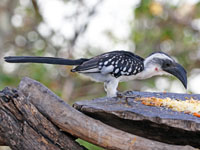
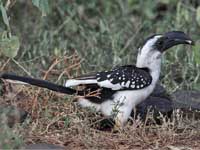
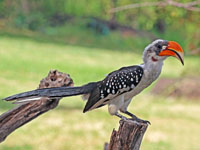
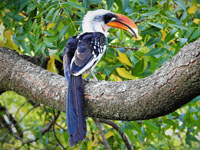
Hornbill,_Monteiro's Tockus monteiri
Description: The Monteiro's hornbill has a black back with white spots. The head, neck, and breast are black. It has a white belly, red bill, and black eyes. It is 50 cm long. This hornbill nests in a natural cavity in a rock face, tree cavity, or artificial nest box. The female emerges from the partially sealed cavity after close to two months and thn helps feed the chicks.
Range: Angola, Namibia.
Habitat: Dry woodlands.
Diet: Mainly insects. It does not eat fruit.
Conservation status: Least Concern.
Image by: 1) Gregoire_Dubois 2) Jeffrey Hotson - Namibia 3) NanosanchezRange: Angola, Namibia.
Habitat: Dry woodlands.
Diet: Mainly insects. It does not eat fruit.
Conservation status: Least Concern.

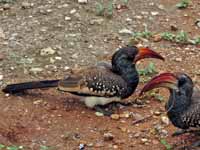
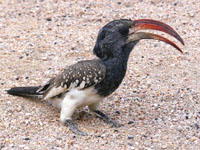
Hornbill,_von der Decken's Tockus deckeni
Description: The Von der Decken's hornbill has black upperparts, a white head with black cap, and a black eye-patch. The underparts are mainly white. The male has a red bill while the female has a black bill. There is a low casque. The similar Jackson's hornbill has white spots on the upperparts, Von der Decken's does not. It is a small hornbill with a length of 35 cm, male weighs 165 to 215 grams, and female weighs 120 to 155 grams. It nests in a tree cavity, old woodpecker hole, or a cliff. The nest is sealed. The female emerges after about 2 months to help the male feed the brood.
Range: East Africa.
Habitat: Savana, scattered woodland.
Diet: Insects, fruit, seeds.
Conservation status: Least Concern.
Image by 1)
Steven G Johnson - the London Zoo 2)
Dick Daniels - Tampa's Lowry Park Zoo 3, 4) Nik_Borrow - Tanzania, EthiopiaRange: East Africa.
Habitat: Savana, scattered woodland.
Diet: Insects, fruit, seeds.
Conservation status: Least Concern.
1, 2, 3) Female 4, 5, 6) Male
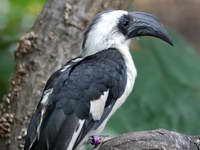

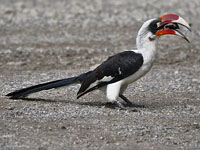

Red-billed Hornbills
The red-billed hornbill has been split into 5 species: Damara red-billed hornbill, northern red-billed hornbill, southern red-billed hornbill, Tanzanian red-billed hornbill, and western red-billed hornbill. The red-hornbills have wings covered in circles of white feathers surrounded by black or dark brown feathers. These five species are listed next for ease of reference.
Hornbill,_Damara_Red-billed Tockus damarensis
Description: The Damara red-billed hornbill is one of the red-bill hornbills; as such, it has a red bill. It is a black and white hornbill with spotted wing-coverts. It usually has a greyish-white belly, but it can be pure white. The upper-tail is black and the under-tail is white. It has brown eyes. This is a small hornbill with a length of 35 cm, male weight 210 grams, and female weight 175 grams. The female leaves the sealed nest when the oldest chick is about 18 days. She then helps the male feed the chicks.
Range: Southwest Angola, northern Namibia.
Habitat: Dry thorn scrub and savanna.
Diet: Mainly invertebrates such as caterpillars, termites, and, centipedes.
Conservation status: Least Concern.
Image by: 1) Hans Hillewaert - Namibia 2) Ron_Knight 3) Graham_DugganRange: Southwest Angola, northern Namibia.
Habitat: Dry thorn scrub and savanna.
Diet: Mainly invertebrates such as caterpillars, termites, and, centipedes.
Conservation status: Least Concern.
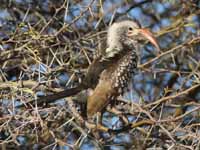
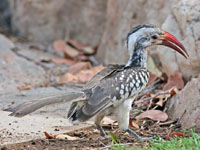
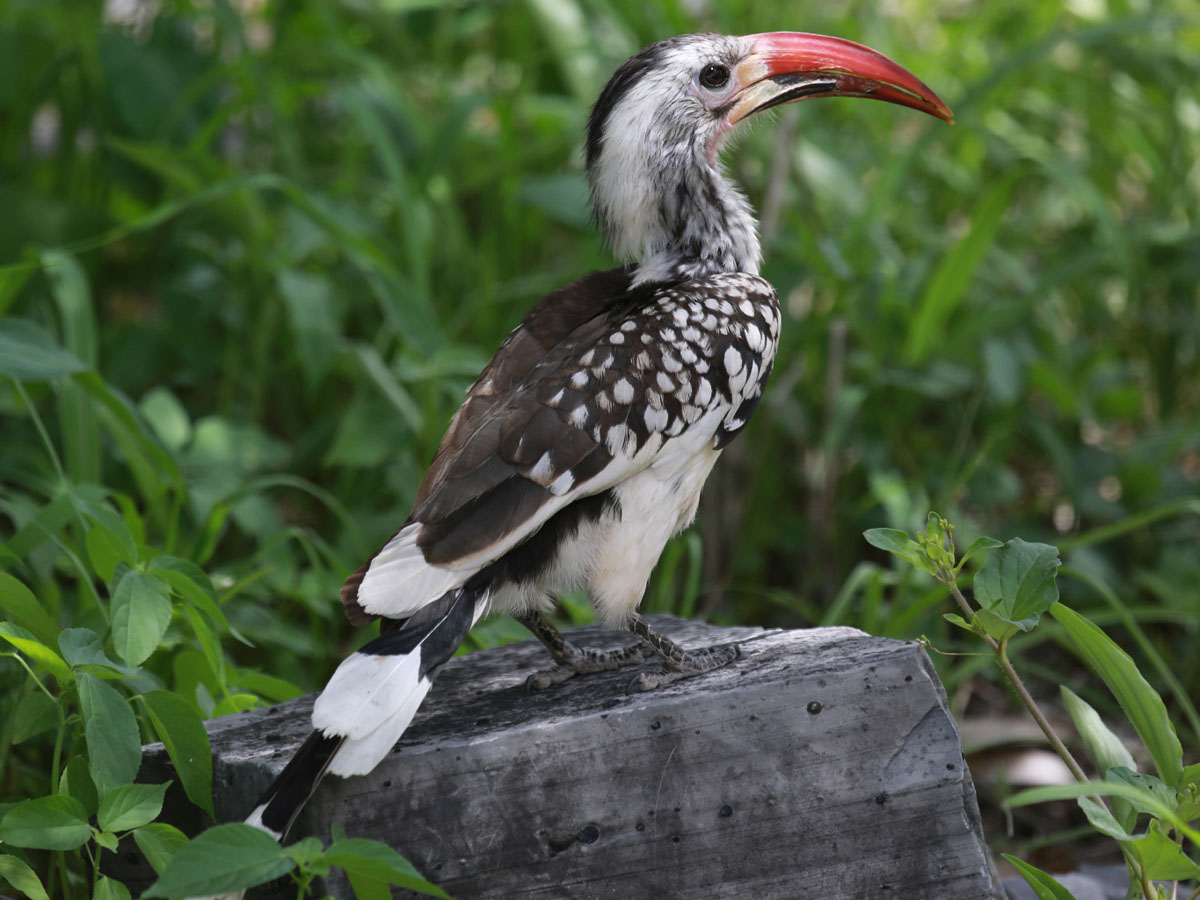
Hornbill,_Northern_Red-billed Tockus erythrorhynchus Found: Africa
Description: The northern red-billed hornbill is one of the red-bill hornbills; as such, it has a red bill. It is a black and white hornbill with spotted wing-coverts. It has brown eyes which have a pale eye-ring. It is a small hornbill with a length of 35 cm, male weight 150 grams, and female weight 125 grams. The female leaves the sealed nest when the oldest chick is about 20 days. She then helps the male feed the chicks.
Range: Central Africa including Nigeria, Chad, Ethiopia, Kenya, Tanzania.
Habitat: Open savanna and woodland.
Diet: Beetles, termites, grasshoppers. Also geckos, chicks, fruit.
Conservation status: Least Concern.
Image by: 1) Alan_Hopkins - Tanzania 2, 3) Nik_Borrow - EthiopiaRange: Central Africa including Nigeria, Chad, Ethiopia, Kenya, Tanzania.
Habitat: Open savanna and woodland.
Diet: Beetles, termites, grasshoppers. Also geckos, chicks, fruit.
Conservation status: Least Concern.
2) Male
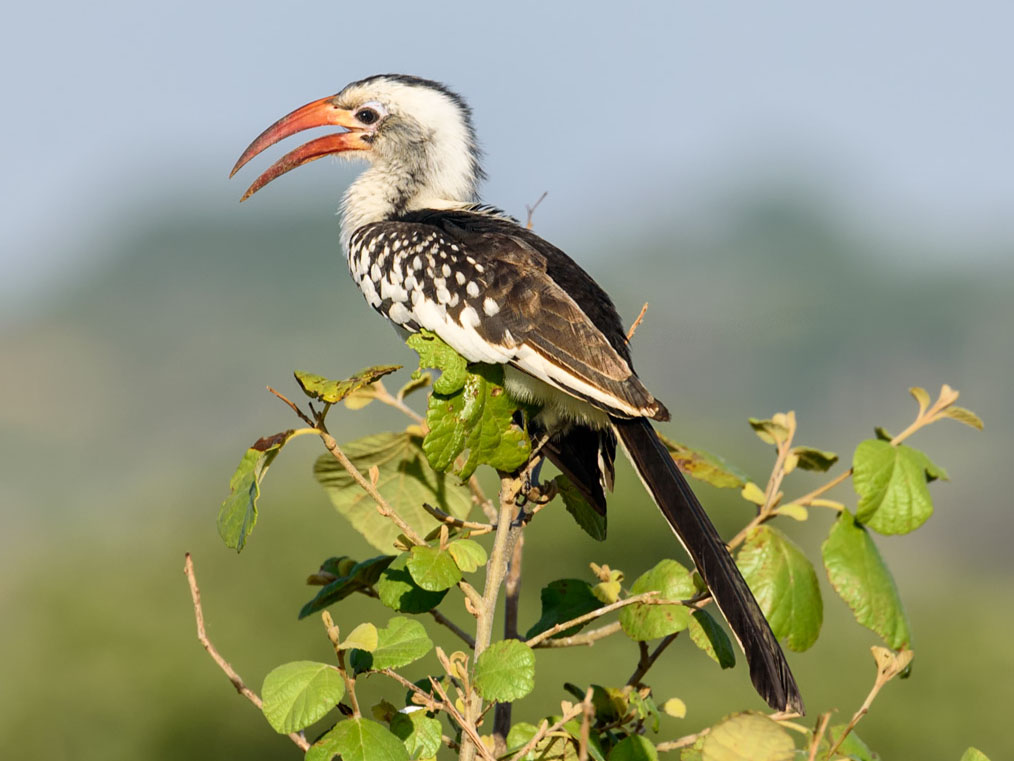
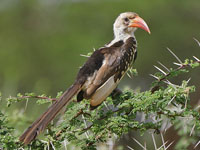
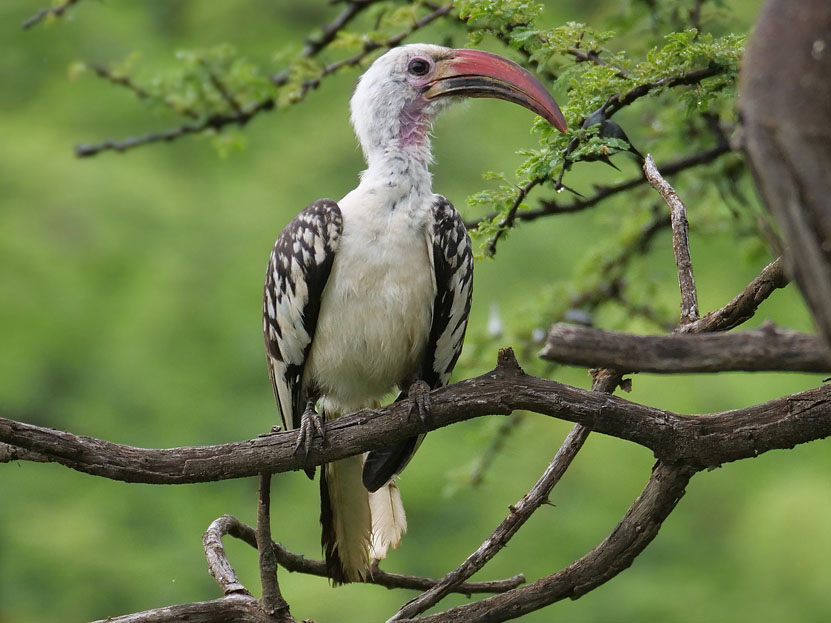
Hornbill,_Southern_Red-billed Tockus rufirostris
Description: The southern red-billed hornbill is one of the red-bill hornbills; as such, it has a red bill. It is a black and white hornbill with spotted wing-coverts. It is distinguishable from other red-billed hornbills by the combination of its yellow iris and pale orbital skin (pink to greyish). It is a small hornbill with a length of 35 cm, male weight 150 grams, and female weight 125 grams. The female leaves the sealed nest when the oldest chick is about 20 days. She then helps the male feed the chicks.
Range: Southern Africa.
Habitat: Open savana and woodland. Also denser forests.
Diet: Beetles, termites, grasshoppers. Also geckos, chicks, fruit.
Conservation status: Least Concern.
Image by: 1) Dick Daniels - Kruger National Park, South Africa 2) Arno_Meintjes 3) Charles_J_Sharp - Kenya 4) Tim_EllisRange: Southern Africa.
Habitat: Open savana and woodland. Also denser forests.
Diet: Beetles, termites, grasshoppers. Also geckos, chicks, fruit.
Conservation status: Least Concern.

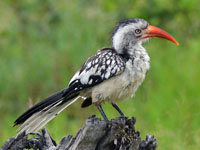
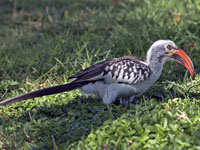
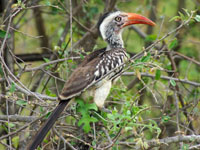
Hornbill,_Tanzanian Red-billed Tockus ruahae
Description: The Tanzanian red-billed hornbill is one of the red-bill hornbills; as such, it has a red bill. It is a black and white hornbill with spotted wing-coverts. It is distinguishable from other red-billed hornbills by the combination of a yellow iris and black patch around the eye. It is 42 to 48 cm long and weighs about 200 grams which makes it larger than most of the other red hornbills, but it is still a relatively small hornbill.
Range: Central Tanzania.
Habitat: Savanna and semi-arid woodland.
Diet: Caterpillars, ants, termites; also frogs.
Conservation status: Least Concern.
Image by: 1) Dick Daniels- Tanzaia 2) Nevit Dilmen - Tanzania 3, 4) Nik_Borrow - TanzaniaRange: Central Tanzania.
Habitat: Savanna and semi-arid woodland.
Diet: Caterpillars, ants, termites; also frogs.
Conservation status: Least Concern.
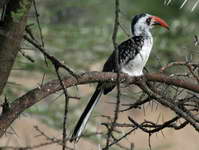

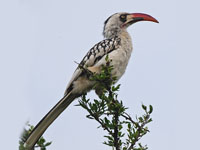
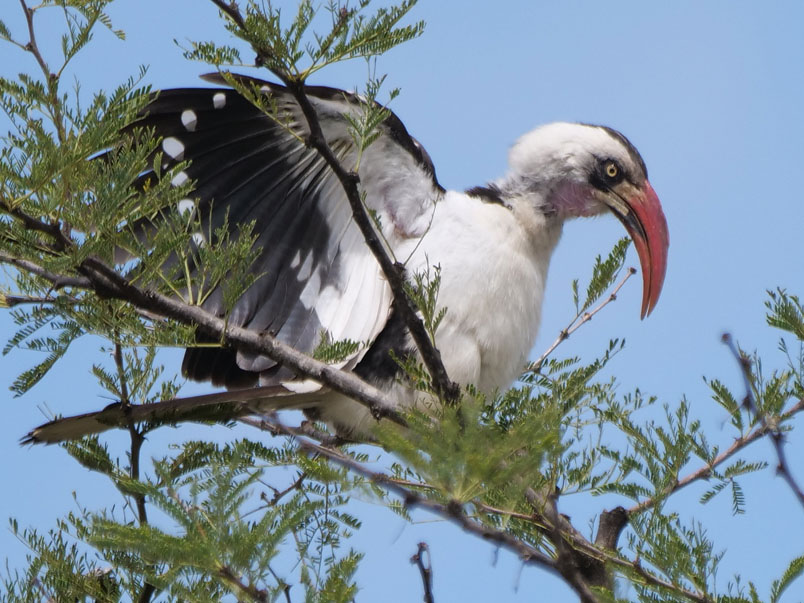
Hornbill,_Western Red-billed Tockus kempi
Description: The western red-billed hornbill is one of the red-bill hornbills; as such, it has a red bill. It is a black and white hornbill with spotted wing-coverts. They have black eyes and dark grey eye-rings which distinguishes it from the other red-billed hornbills. It is 35 cm long, female weighs about 130 grams, and male about 160 grams. The female exits the sealed nest when the oldest chick is two to three weeks old. She then helps the male in the feeding of the brood.
Range: Senegal and Gambia to southern Mauritania and western Mali.
Habitat: Savana and open woodland.
Diet: Beetles, grasshoppers, termintes. Also geckos, chicks.
Conservation status: Least Concern.
Image by:
1) Allan Hopkins - Gambia 2) Thomas Brown 3) Charles J Sharp - Gambia 4) Nik_Borrow - SenegalRange: Senegal and Gambia to southern Mauritania and western Mali.
Habitat: Savana and open woodland.
Diet: Beetles, grasshoppers, termintes. Also geckos, chicks.
Conservation status: Least Concern.


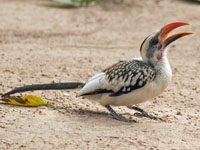
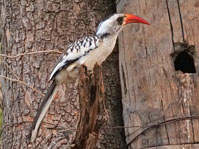
Yellow-billed Hornbills
The yellow-billed hornbill has been split into 2 species: eastern yellow-billed hornbill and southern yellow-billed hornbill. These species are listed next for ease of reference.
Hornbill,_Eastern_Yellow-billed Tockus flavirostris Found: Africa
Description: The eastern yellow-billed hornbill. also known asthe northern yellow-billed hornbill, has a black back with abundant white spots and stripes. It has a grey neck, white belly, and a yellow bill with a small casque. It has blackish skin around the eyes while the similar southern yellow-billed hornbill has pinkish skin around the eyes. It is 40 cm long, male weighs about 250 grams, and female about 180 grams.
Range: Ethiopia, Kenya, Tanzania, and other countries in eastern Africa.
Habitat: Savana with thornbush, and open woodland.
Diet: Grasshoppers, locusts, termites, beetles, caterpillars, fruit. Forages mainly on the ground.
Conservation status: Least Concern.
Image by: 1) Eric - Discovery Cove, Orlando, Florida 2) Greg Hume - Cincinnati Zoo 3) Steve_Garvie 4) Nik_Borrow - EthiopiaRange: Ethiopia, Kenya, Tanzania, and other countries in eastern Africa.
Habitat: Savana with thornbush, and open woodland.
Diet: Grasshoppers, locusts, termites, beetles, caterpillars, fruit. Forages mainly on the ground.
Conservation status: Least Concern.
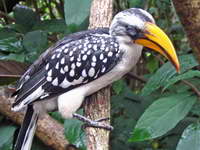
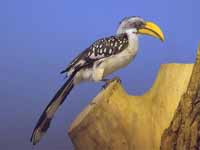
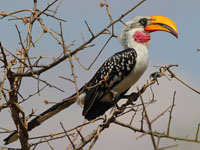
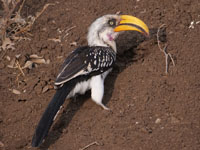
Hornbill,_Southern Yellow-billed Tockus leucomelas Found: Africa
Description: The southern yellow-billed hornbill has a black back with abundant white spots and stripes. It has a grey neck, white belly, and a yellow bill with a small casque. It has pinkish skin around the eyes while the similar eastern yellow-billed hornbill has blackish skin around the eyes.
Range: Namibia, Zimbabwe, South Africa and other southern African countries.
Habitat: Semi-desert with available water, savana, and open woodland.
Diet: Grasshoppers, locusts, termites, beetles, caterpillars, fruit. Forages mainly on the ground.
Conservation status: Least Concern.
Image by: 1) Derek_Keats - South Africa 2) Yathin_Krishnappa 3) Dick - South Africa 4) Cristiano Crolle - Namibia Range: Namibia, Zimbabwe, South Africa and other southern African countries.
Habitat: Semi-desert with available water, savana, and open woodland.
Diet: Grasshoppers, locusts, termites, beetles, caterpillars, fruit. Forages mainly on the ground.
Conservation status: Least Concern.
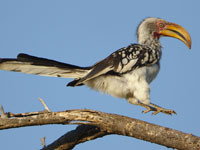

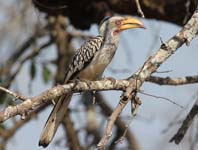

GROUND HORNBILLs
Order Bucerotiformes Family Bucorvidae
Order Bucerotiformes Family Bucorvidae
The family Bucorvidae has only two members, the Abyssinian ground-hornbill and the southern ground-hornbill. They are both found in Sub-Saharan Africa. Ground hornbills are large, with adults around a meter tall. Both species are ground-dwelling, unlike other hornbills, and feed on insects, snakes, other birds, amphibians and even tortoises. They only fly when they are alarmed.
The Abyssinian ground-hornbill in captivity lives 35 ot 40 years. The larger southern species is possibly the slowest-breeding species and one of the longest-lived of all birds.They eat a wide variety of small vertebrates and invertebrates, including tortoises, lizards, snakes, birds, spiders, beetles, and caterpillars; they also take carrion, some fruits, seeds, and groundnuts.
Similar to the hornbills of family Bucerotidae, the ground-hornbills nest mainly in tree cavities, but also holes in rocks. These cavities are also partially sealed when the female is ready to lay eggs. A mixture of mud and vegetation is used accomplish the closure. Prior to construction, the male lines the cavity with dry leaves. The female usually lays 1 to 2 eggs with a three to five day separation between the eggs. The first born chick is usually 3 to 5 days older than its sibling; as result it is considerably larger and usually gets the majority of food so the younger chick dies. In essence, the second chick was an insurance policy. If the first born is defective, then chick number 2 gets lucky, otherwise life is hard.
Genus Bucorvus
Hornbill,_Abyssinian ground- Bucorvus abyssinicus
Description: The Abyssinian ground-hornbill, also known as the northern ground-hornbill, has mainly black plumage. The primary flight feathers are white. The long black bill has a reddish patch at its base. There is a short but high casque on top of the bill. The male has an inflatable patch of bare skin on the throat which is red, changing to blue on the upper-throat. The smaller but similar female has all of the red on the throat replaced with dark blue. In captivity they can live 35 to 40 years. It is 90 to 110 cm tall and weighs approximately 4 kg. As is true for all hornbills, the female lays her eggs in a partially sealed cavity nest. When the oldest chick is 3 to 4 weeks old the mother leaves the partially sealed nest to help in food provision.
Range: Northern Sub-Saharan Africa.
Habitat: Savana and scrub in dry areas.
Diet: Lizards, spiders, beetles, caterpillars. Also carrion, fruit, seeds.
Conservation status: It is listed as Vulnerable because of habitat degradation and hunting. A low breeding rate makes it difficult to compensate for losses.
Image by: 1) Alois Staudacher 2) Radomil 3, 4) Dick Daniels - San Diego ZooRange: Northern Sub-Saharan Africa.
Habitat: Savana and scrub in dry areas.
Diet: Lizards, spiders, beetles, caterpillars. Also carrion, fruit, seeds.
Conservation status: It is listed as Vulnerable because of habitat degradation and hunting. A low breeding rate makes it difficult to compensate for losses.
1, 2) Female 3, 4) Male

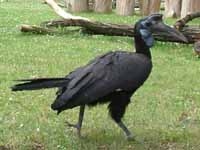
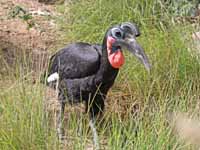
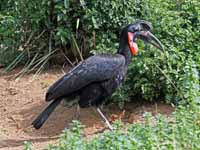
Hornbill,_Southern Ground- Bucorvus leadbeateri
Description: The southern-hornbill has black plumage, The bill is long and relatively straight wih a small casque. The male has red bare skin on its throat while the female has some blue throat skin at the top of its throat, but much of the bare skin is red. It is 90 to 130 cm long, male weighs 3.5 to 6.2 kg, and female weighs 2.2 to 4.6 kg.
As is true for all hornbills, the female lays her eggs in a partially sealed cavity nest. In addition to the adult male, there are at least two other helpers that bring food to the enclosed female parent and also to the chick. The practice obtained by being a helper seems to be an important step in learning how to successfully raise an offspring. Southern-ground hornbills may be unique in the avian world by taking about 6 years before coupling and having young. This late start at reproduction is compensated by a very long life. In captivity one has lived to 70 years. Timbering, poisoning, and hunting are all detrimental to its survival.
Range: Southern Africa; specifically, south from Namibia and Angola.
Habitat: Savanna habitat with large trees for nesting and dense, but short grass for foraging.
Diet: Reptiles, frogs, snails, insects and mammals up to the size of hares.
Conservation status: The southern ground-hornbill is listed as Vulnerable. A major contributing factor is its extremely slow reproductive rate - they don't start reproducing until 6 years old, do not breed every year, and only have a maximum of one surving chick each time they do breed.
Image by:1) Nik Borrow - Tanzania 2) Bernard_Dupont - South Africa 3) Arno Meintjes 4) Dick Daniels - World
of Birds,
As is true for all hornbills, the female lays her eggs in a partially sealed cavity nest. In addition to the adult male, there are at least two other helpers that bring food to the enclosed female parent and also to the chick. The practice obtained by being a helper seems to be an important step in learning how to successfully raise an offspring. Southern-ground hornbills may be unique in the avian world by taking about 6 years before coupling and having young. This late start at reproduction is compensated by a very long life. In captivity one has lived to 70 years. Timbering, poisoning, and hunting are all detrimental to its survival.
Range: Southern Africa; specifically, south from Namibia and Angola.
Habitat: Savanna habitat with large trees for nesting and dense, but short grass for foraging.
Diet: Reptiles, frogs, snails, insects and mammals up to the size of hares.
Conservation status: The southern ground-hornbill is listed as Vulnerable. A major contributing factor is its extremely slow reproductive rate - they don't start reproducing until 6 years old, do not breed every year, and only have a maximum of one surving chick each time they do breed.
1, 2) Female 3, 4) Male

